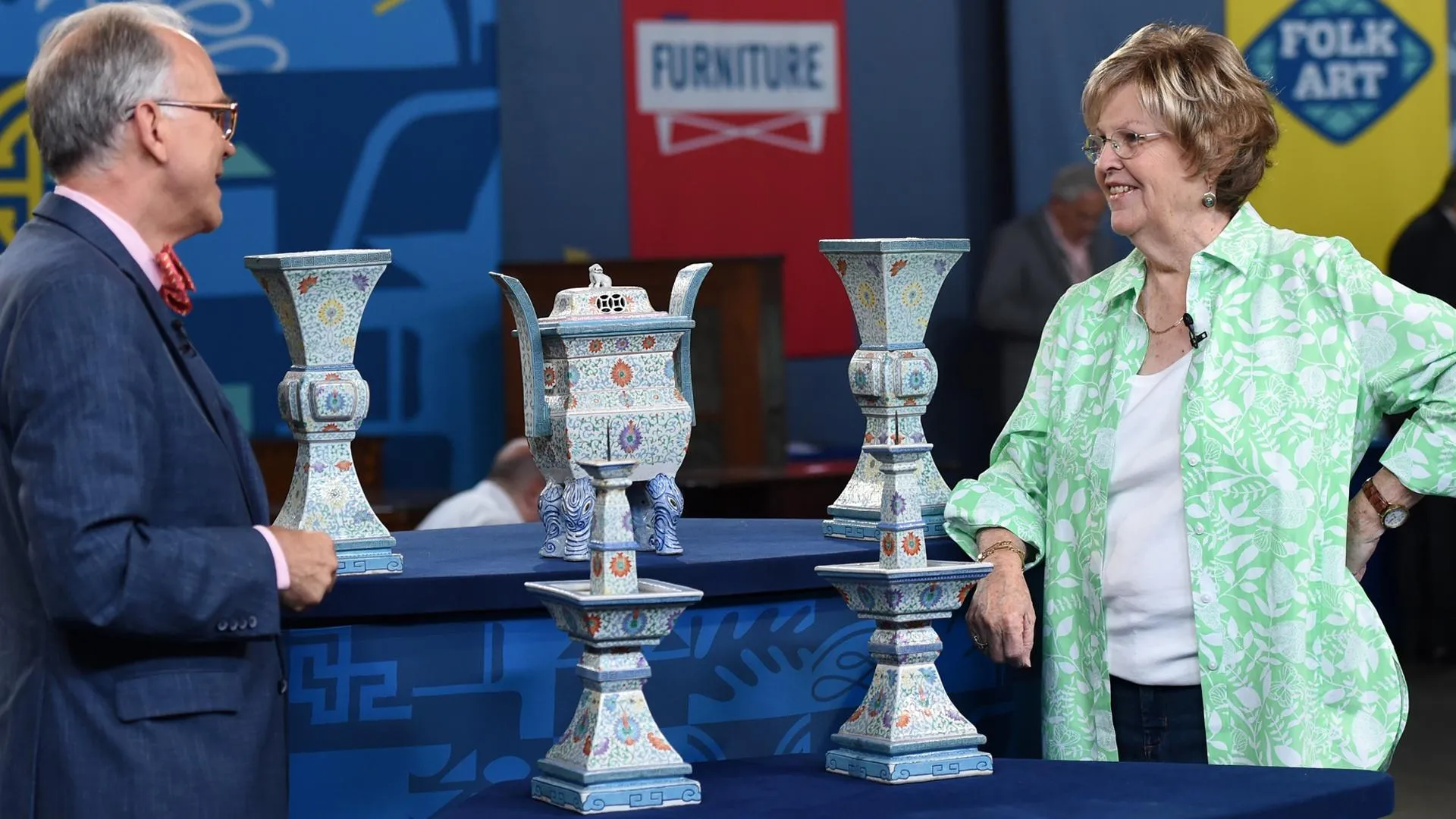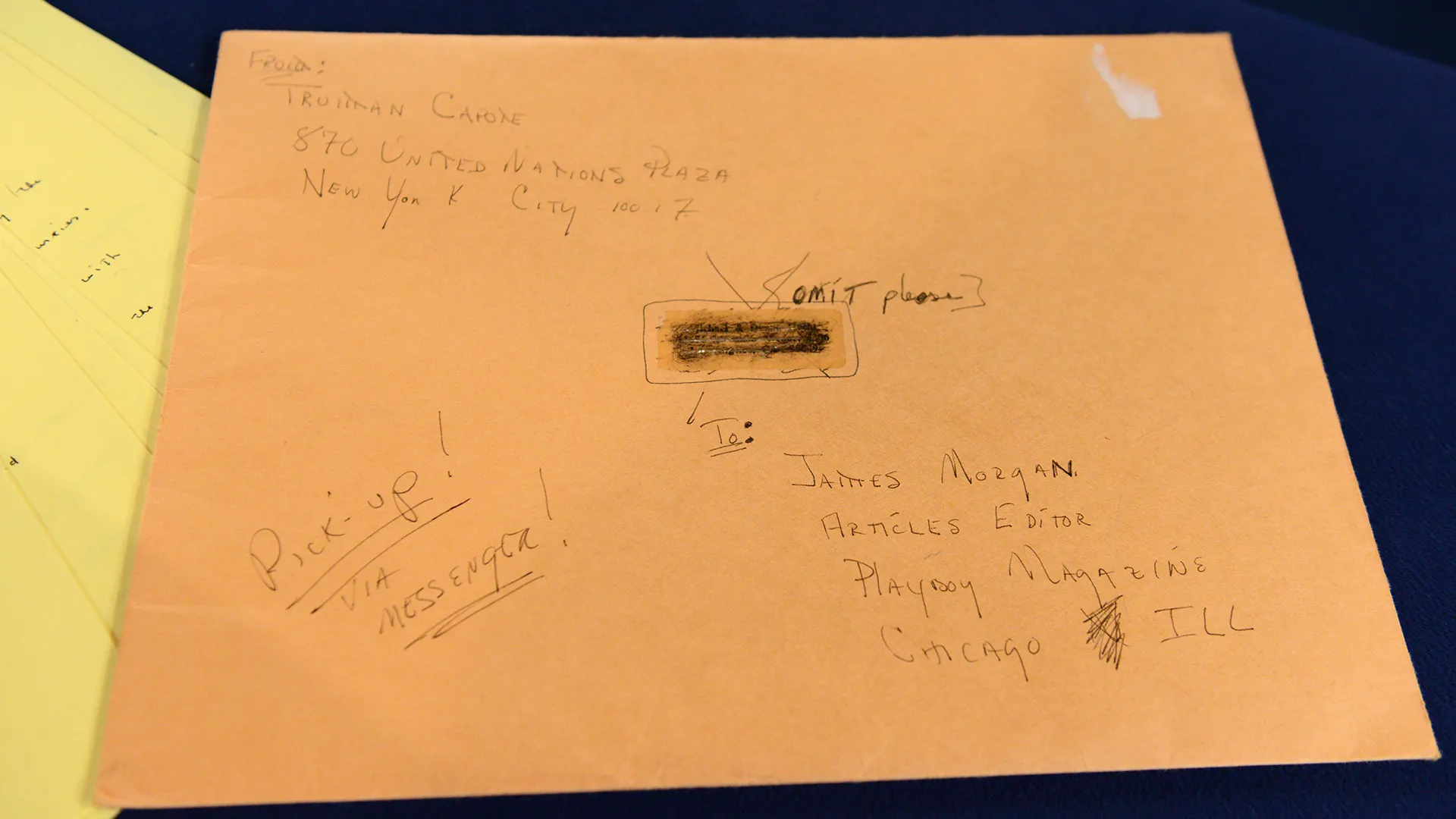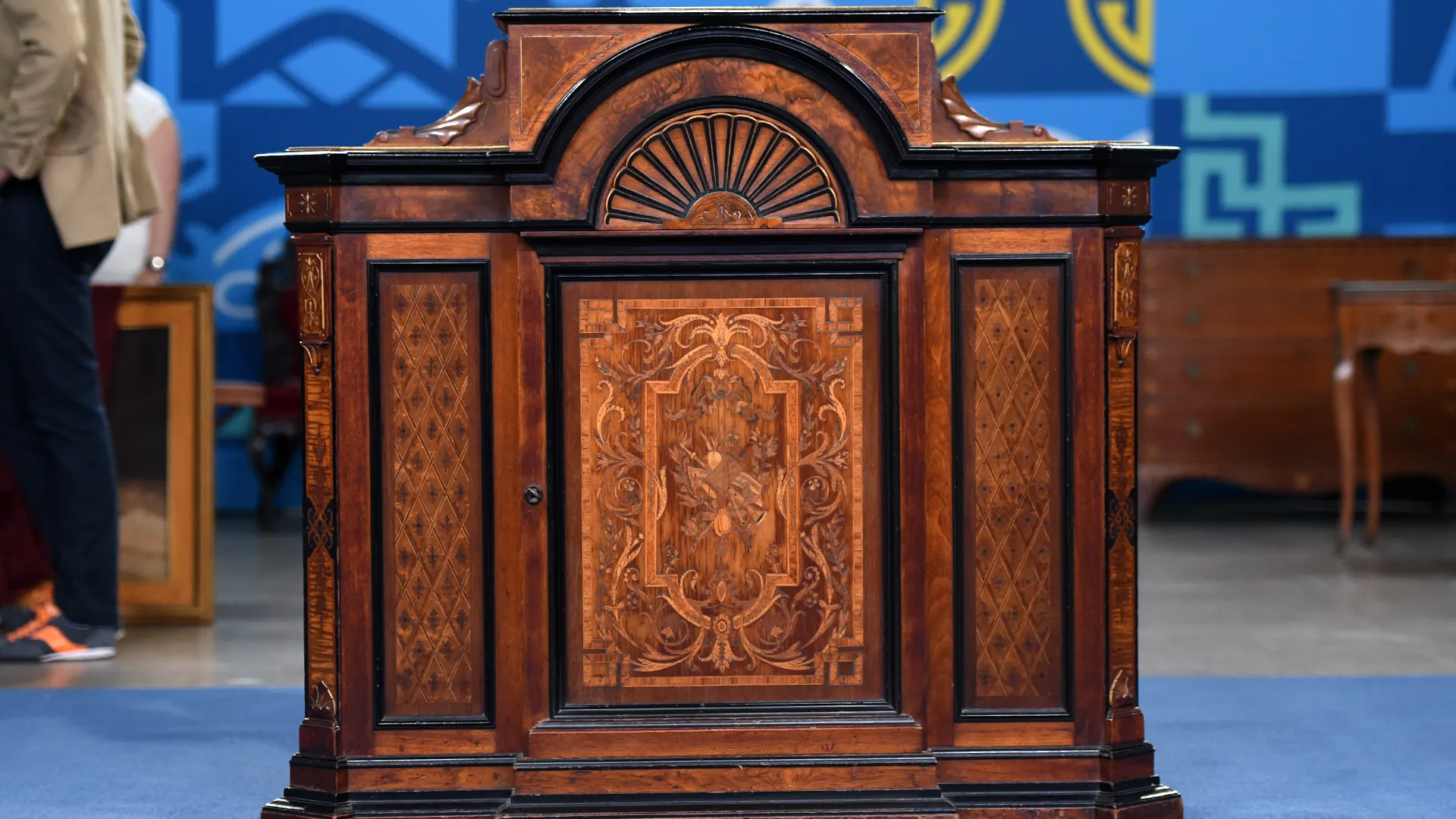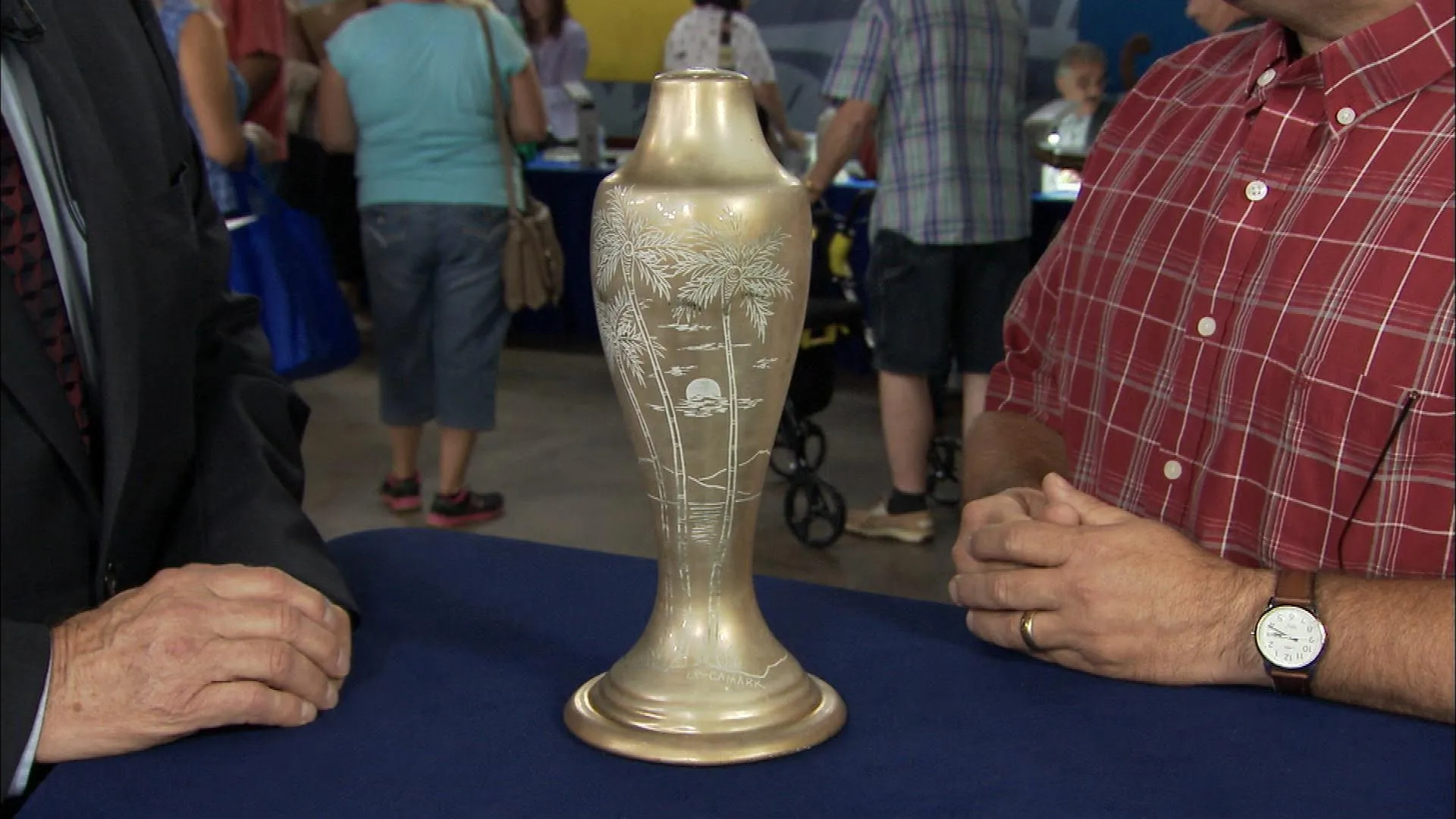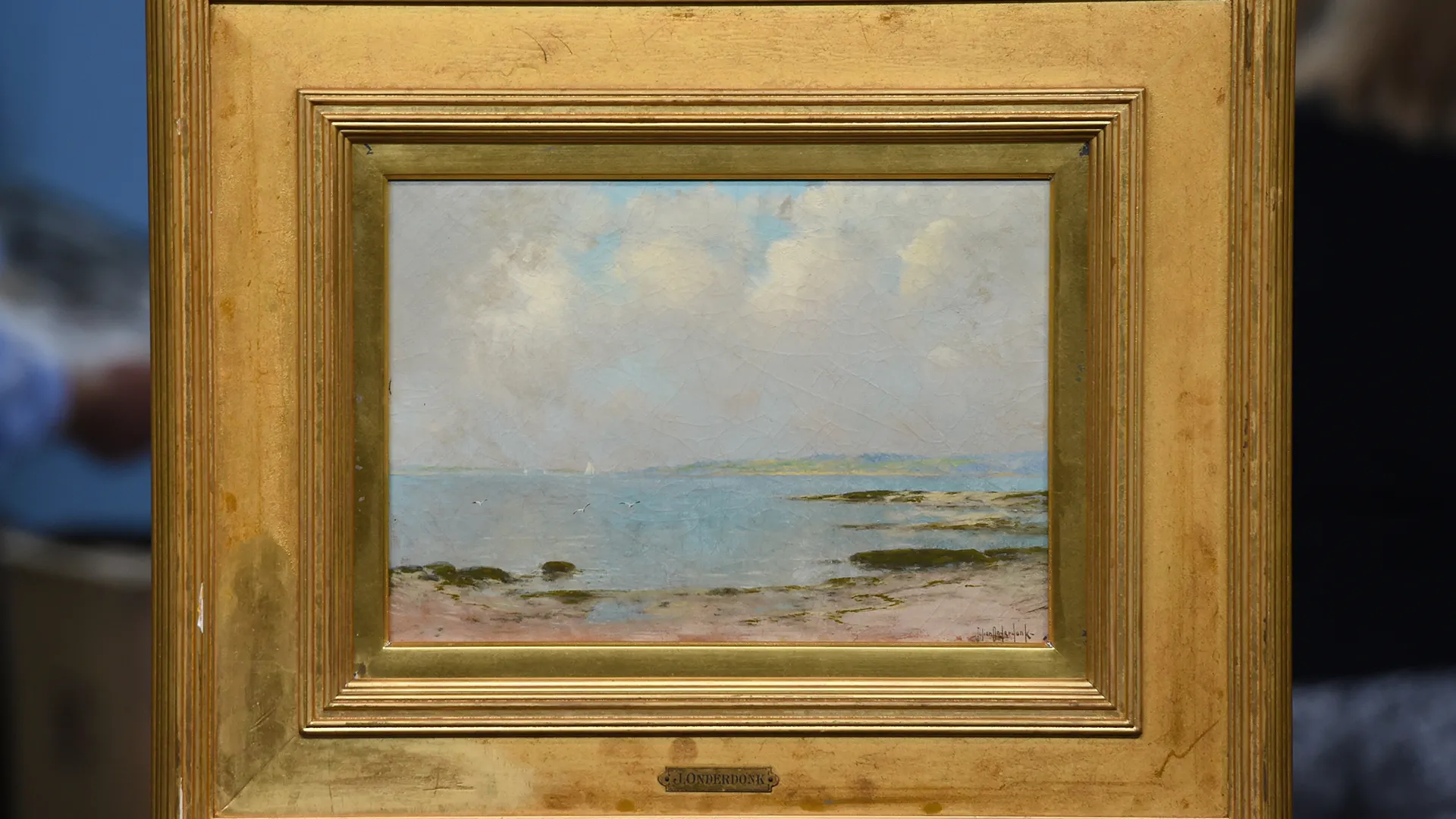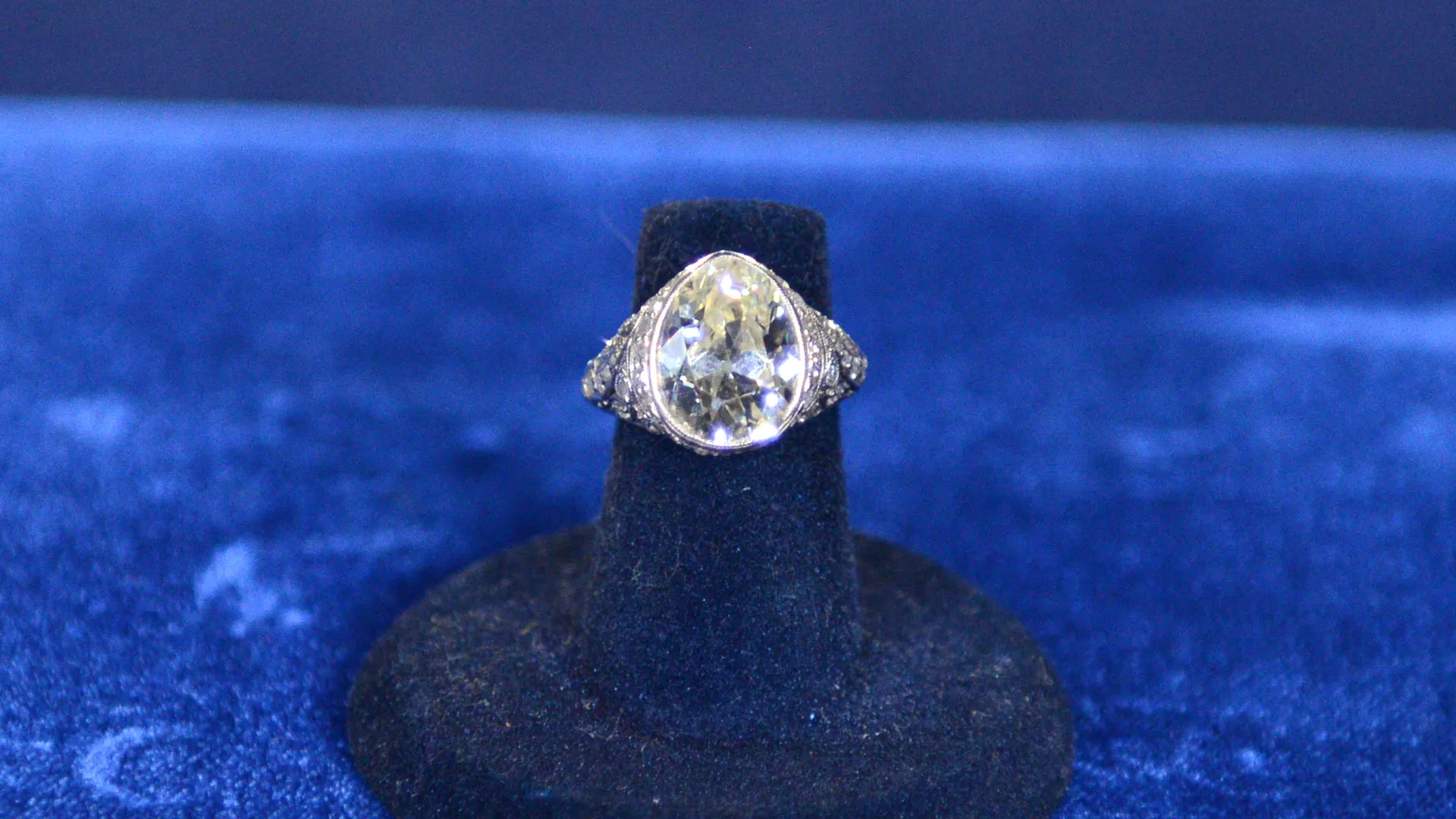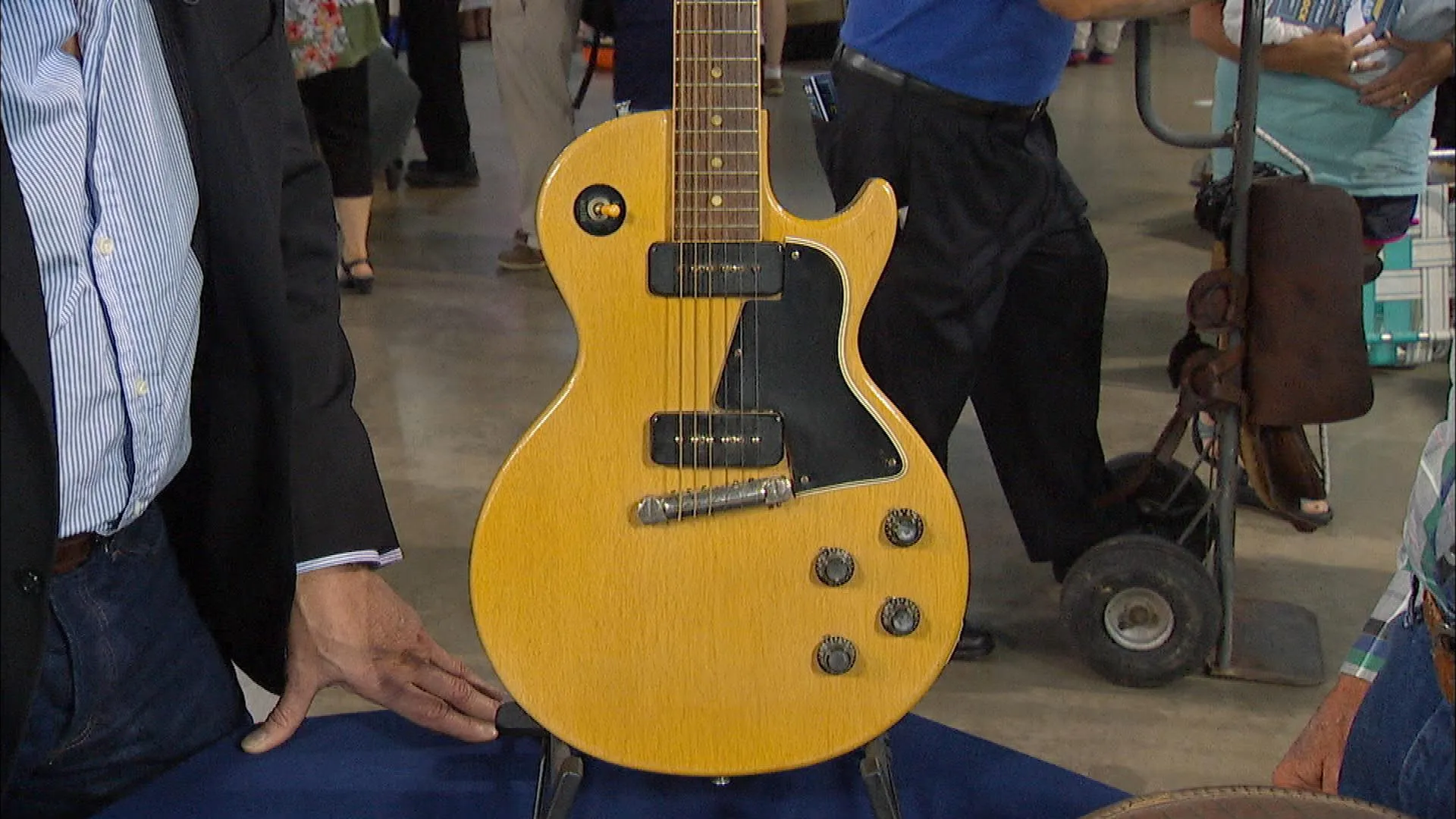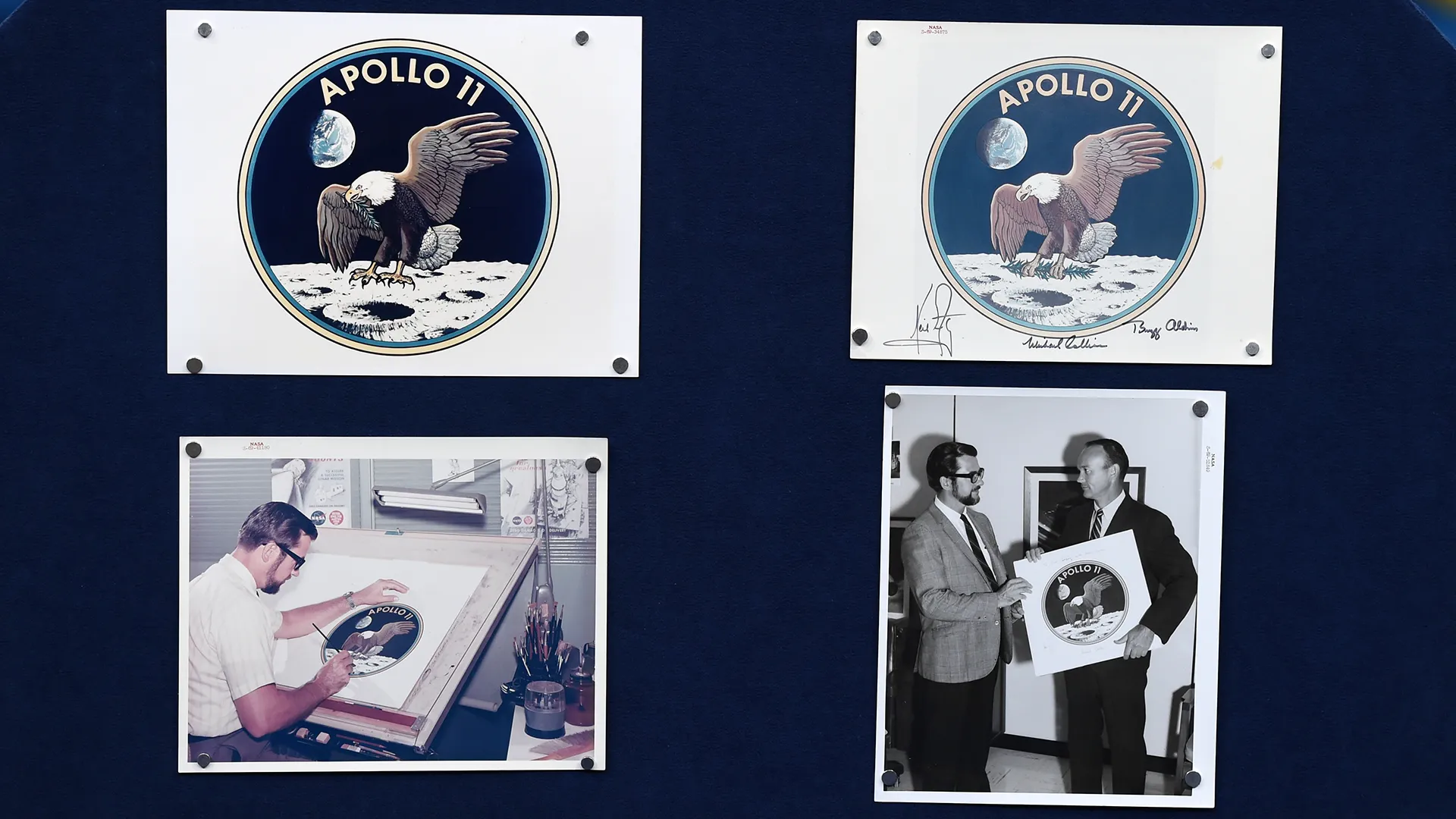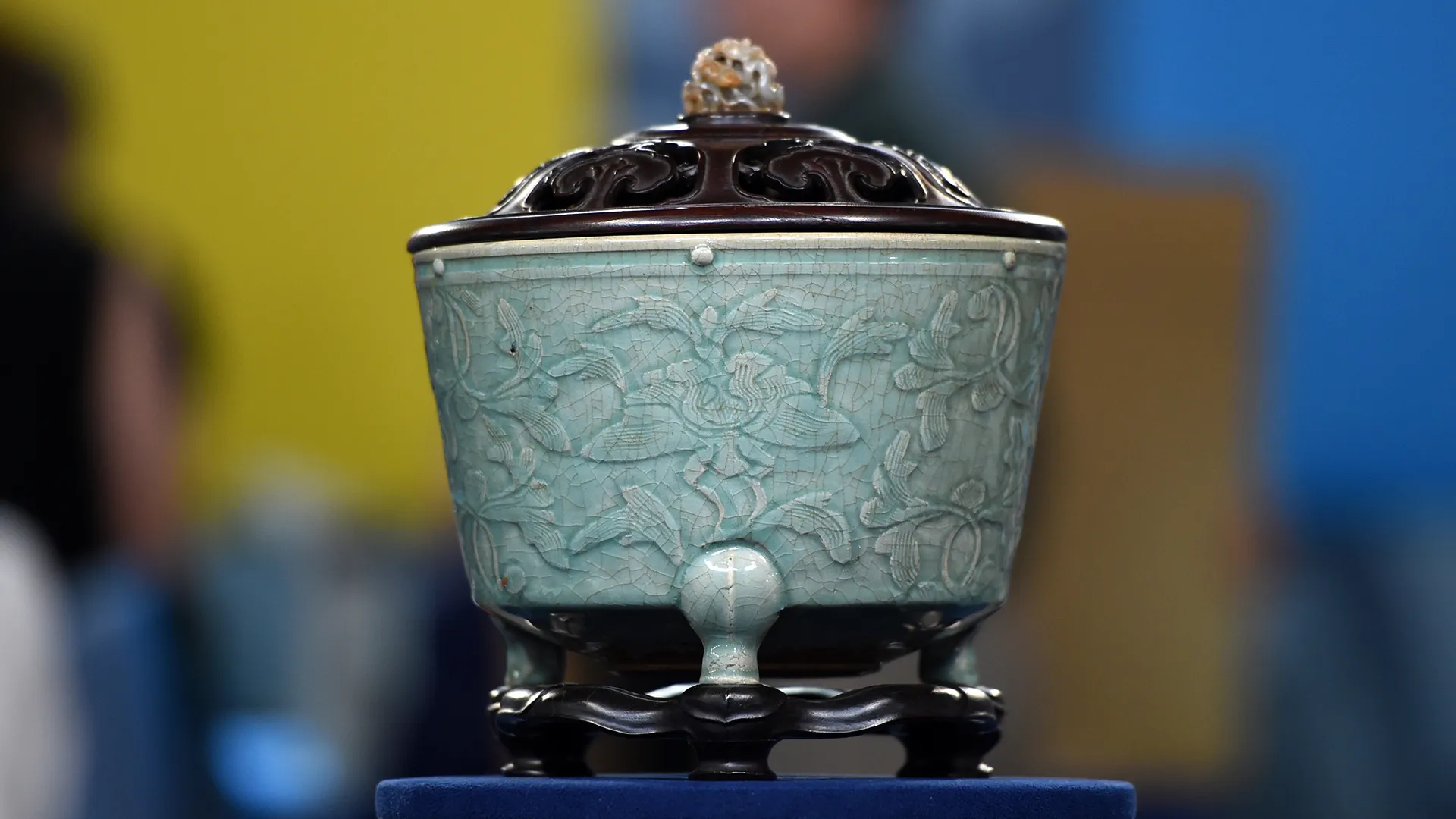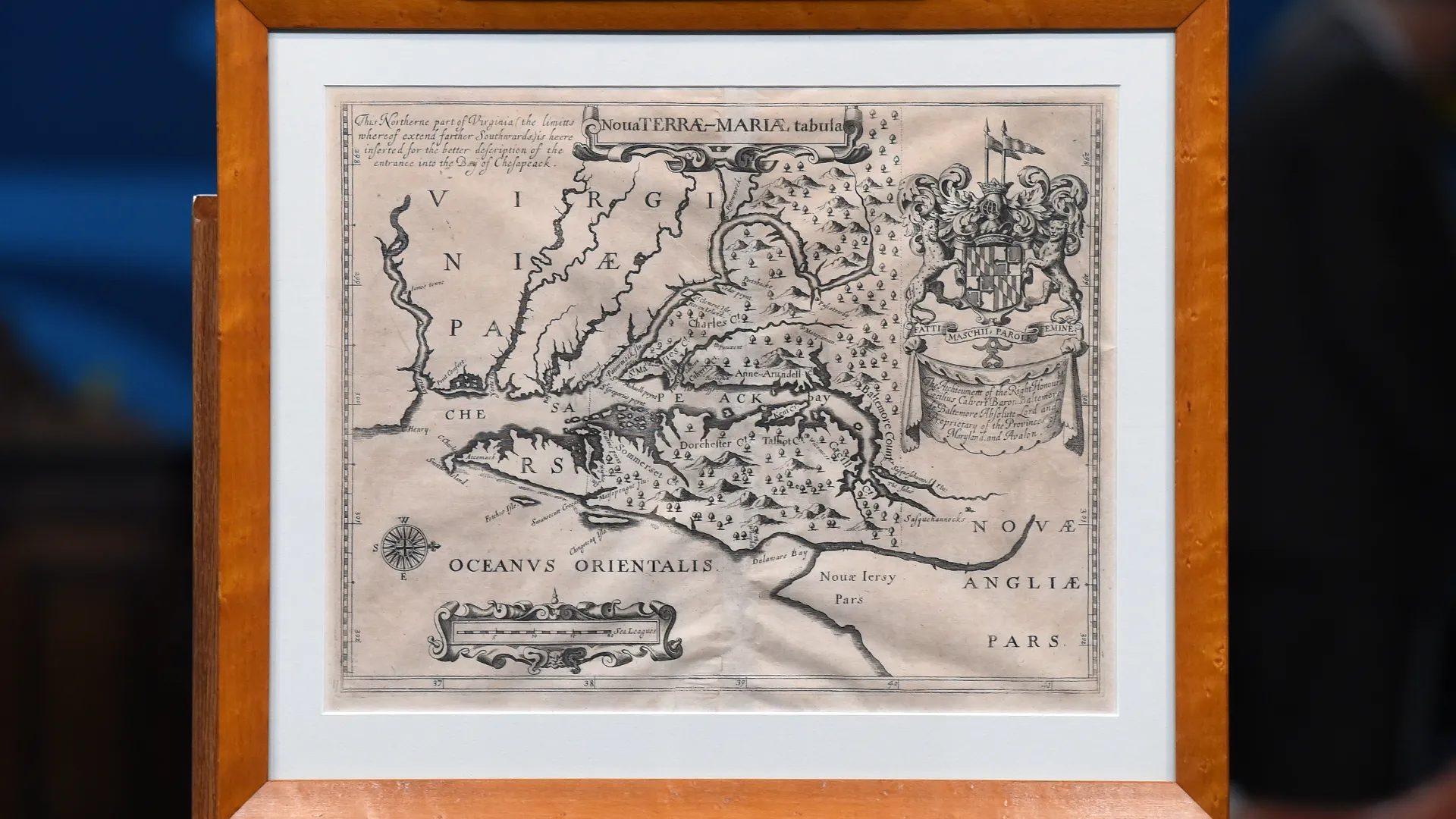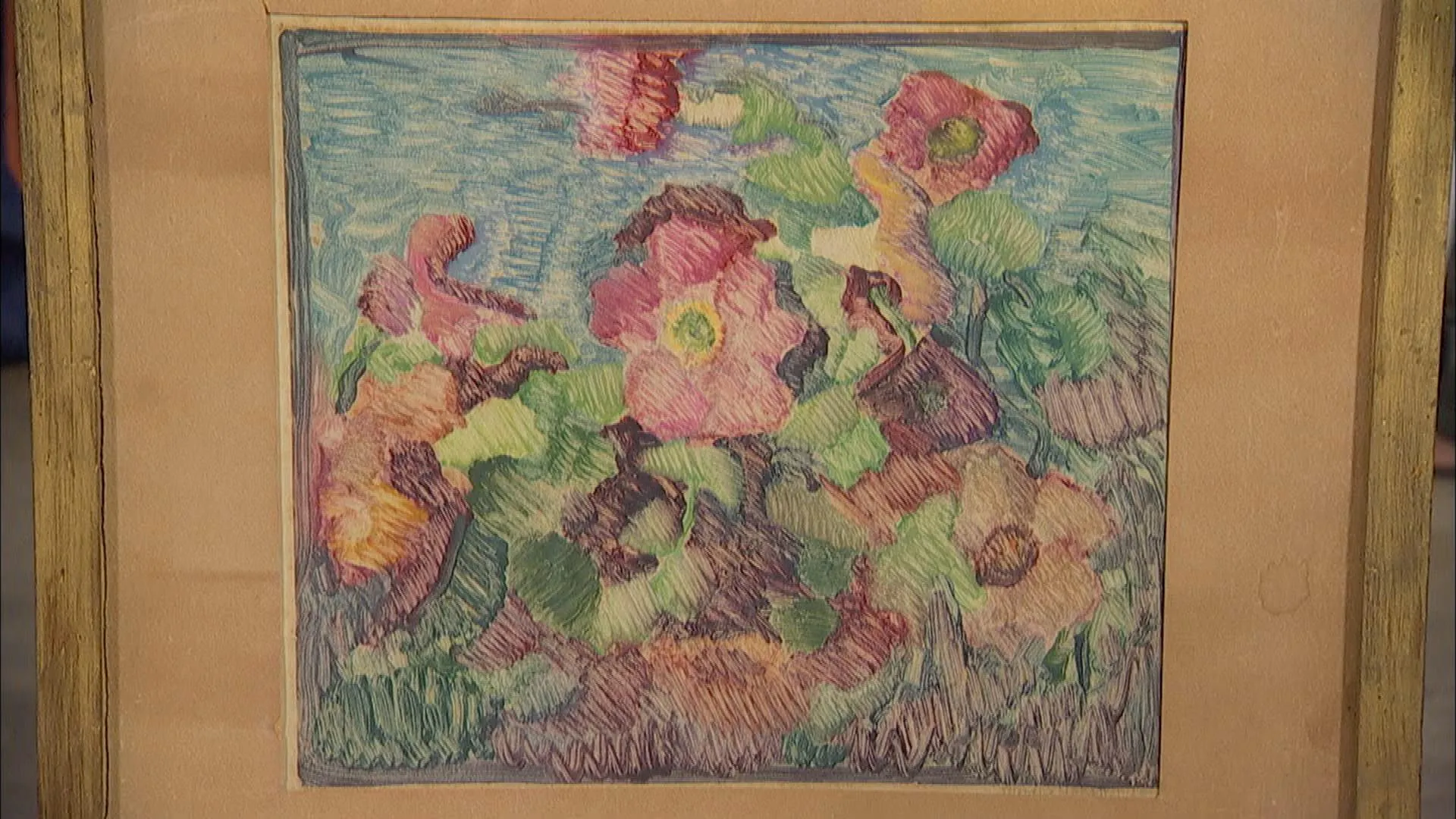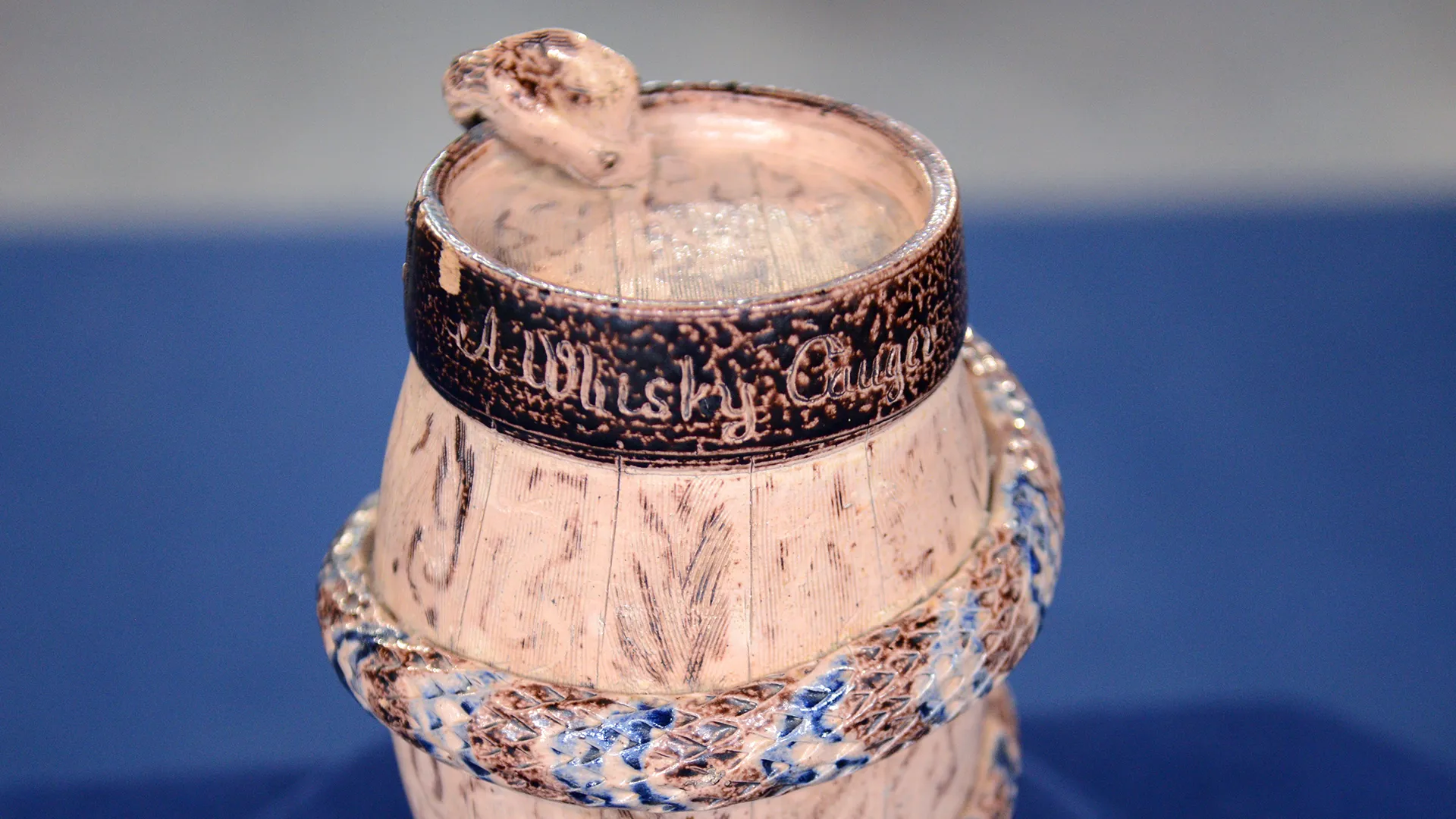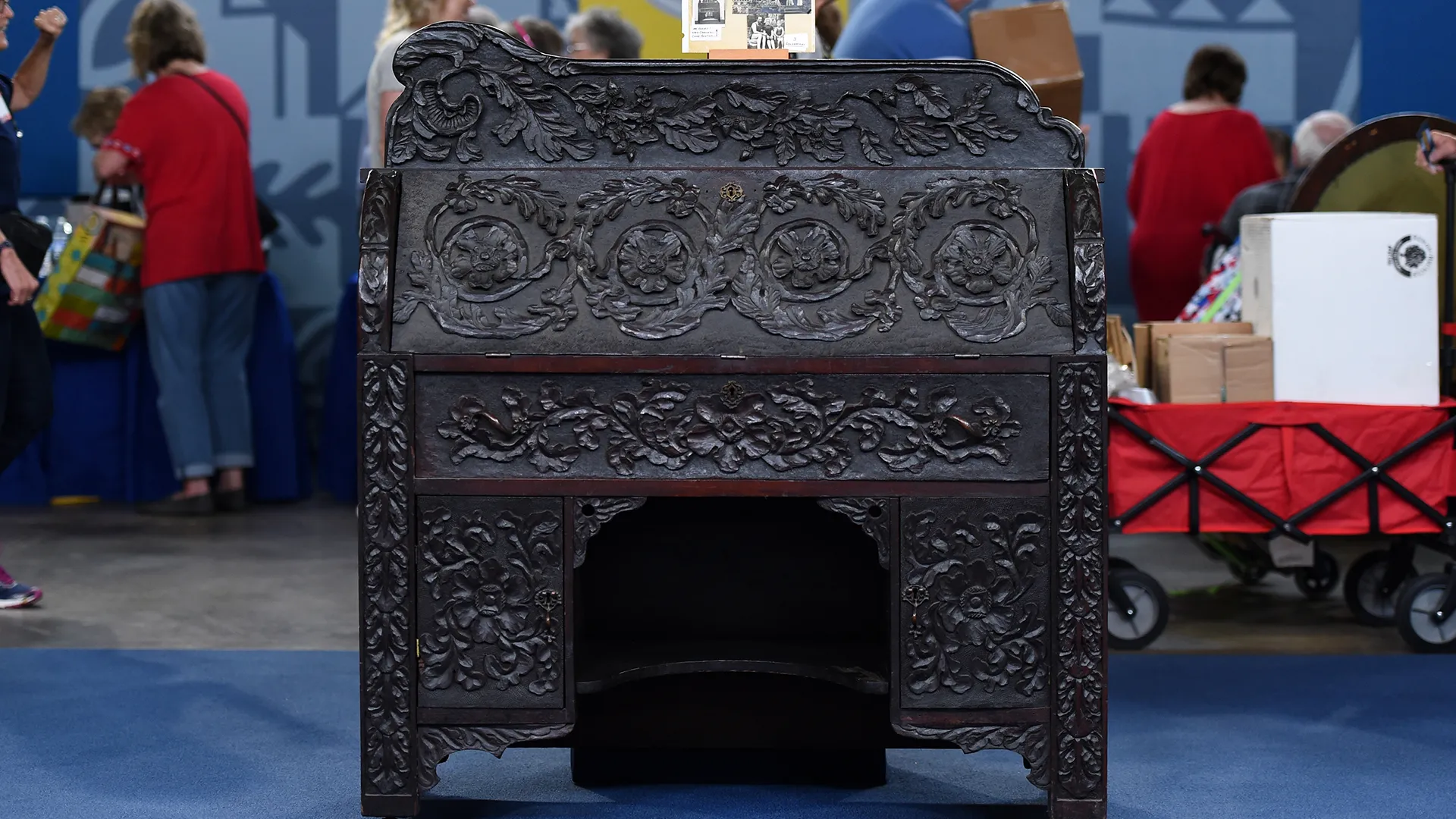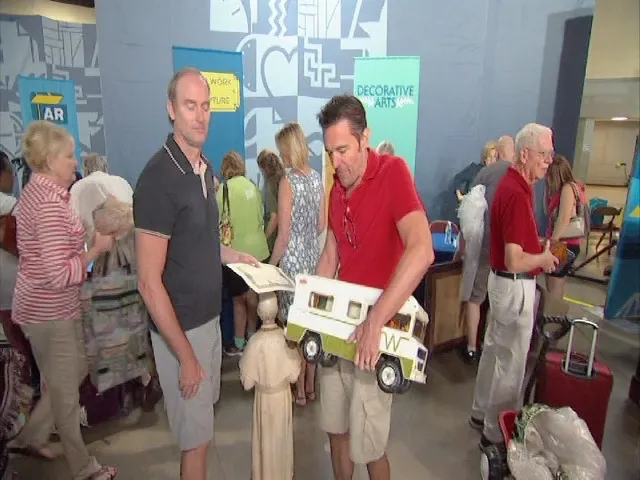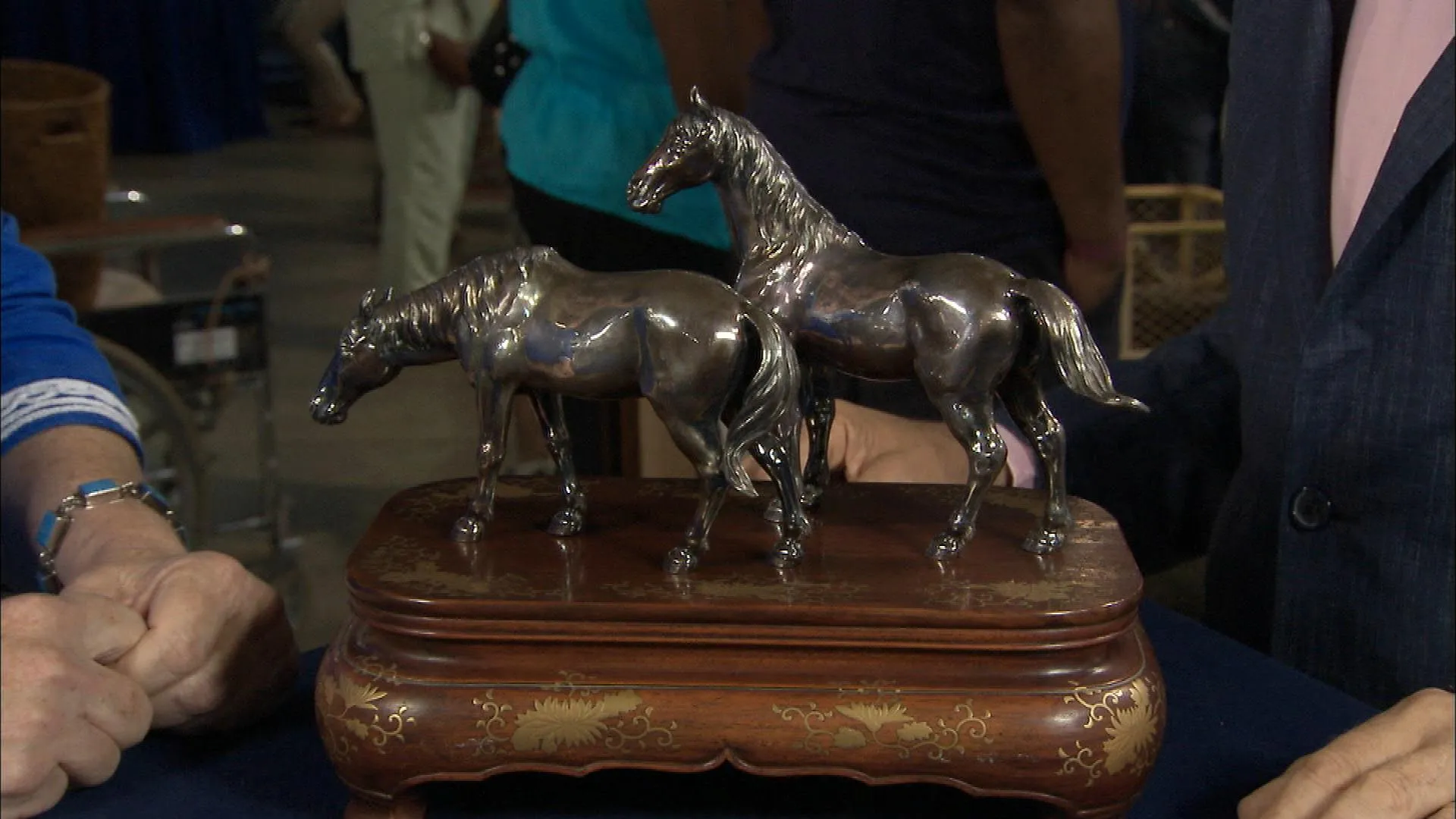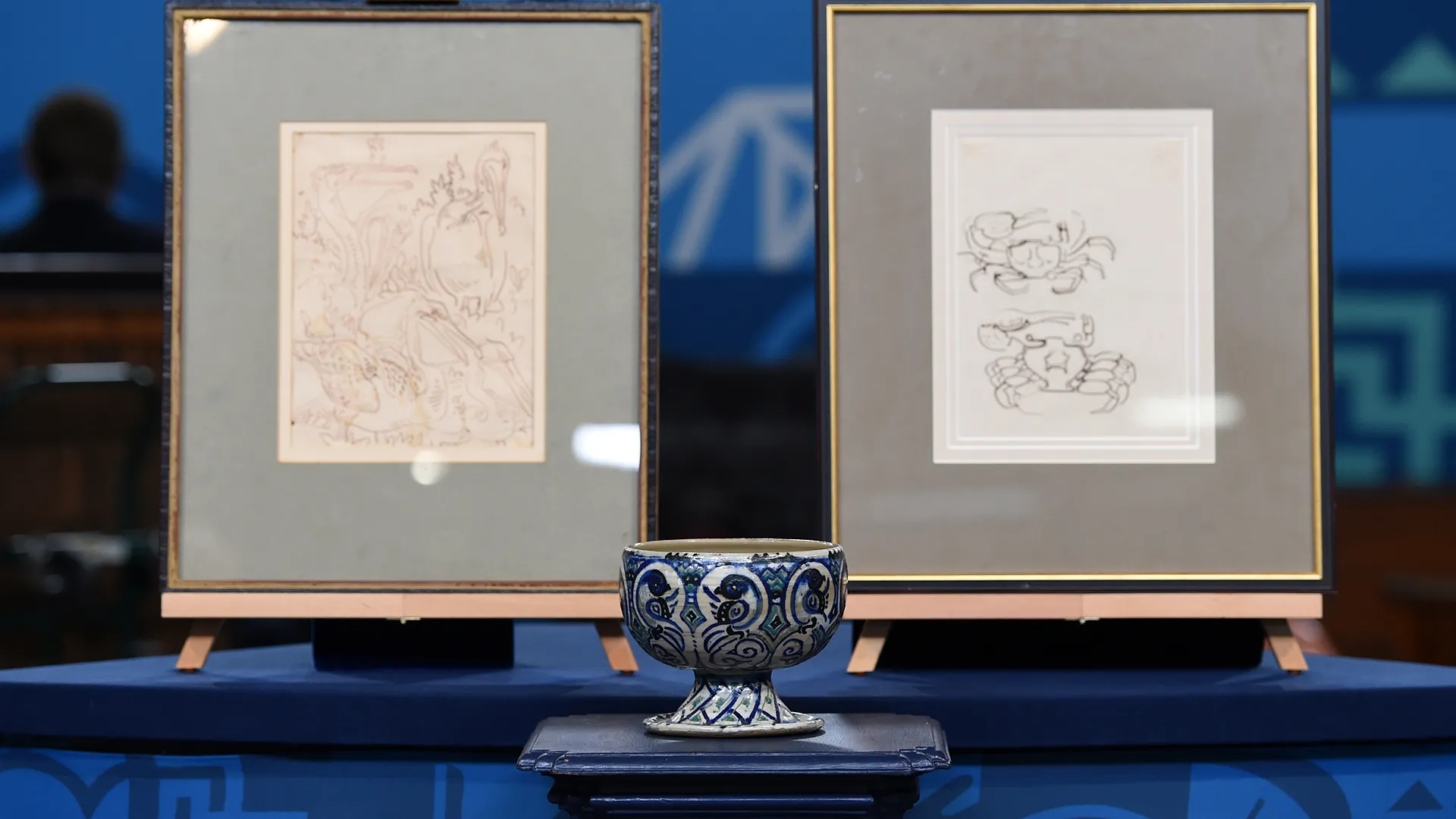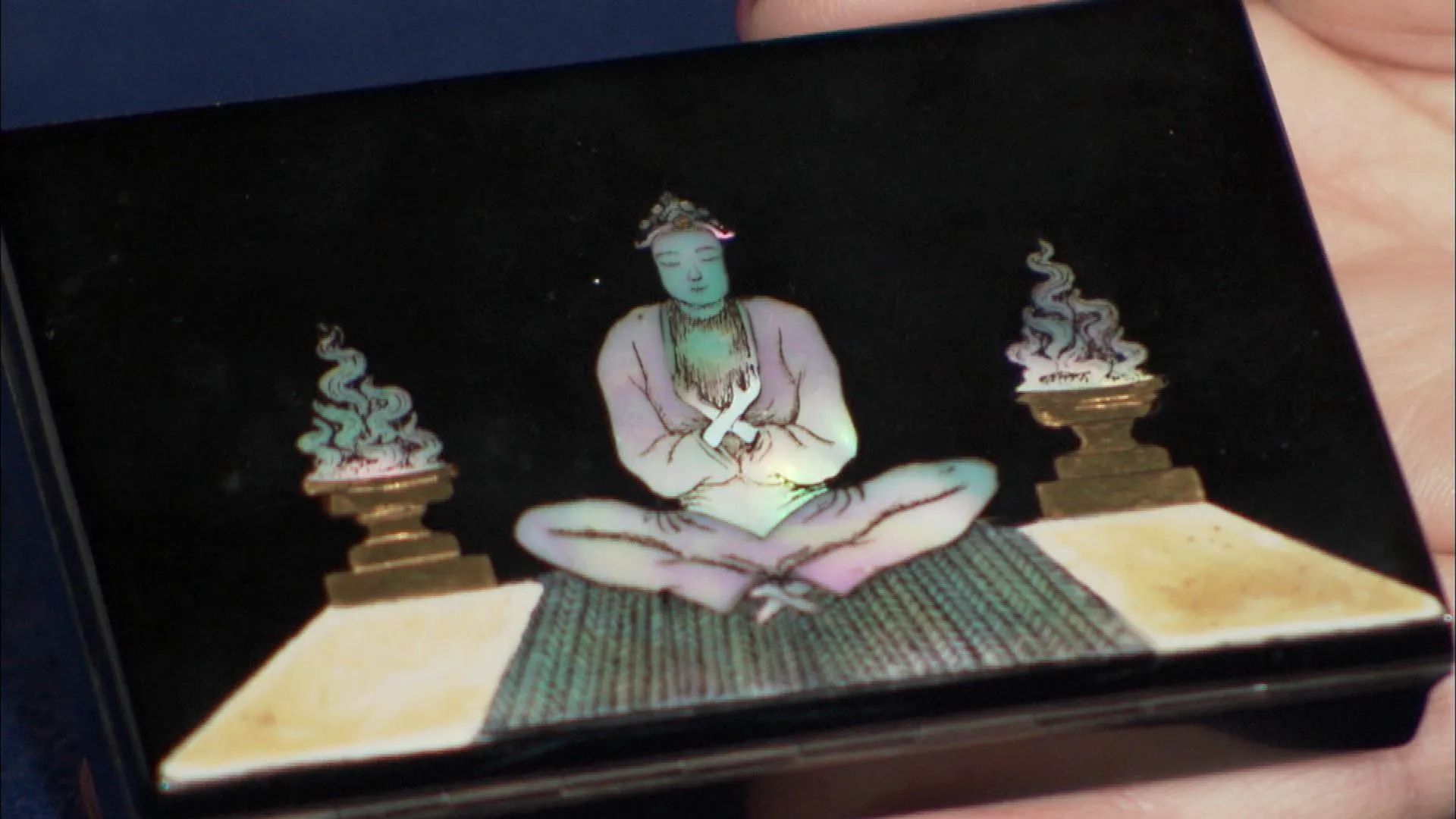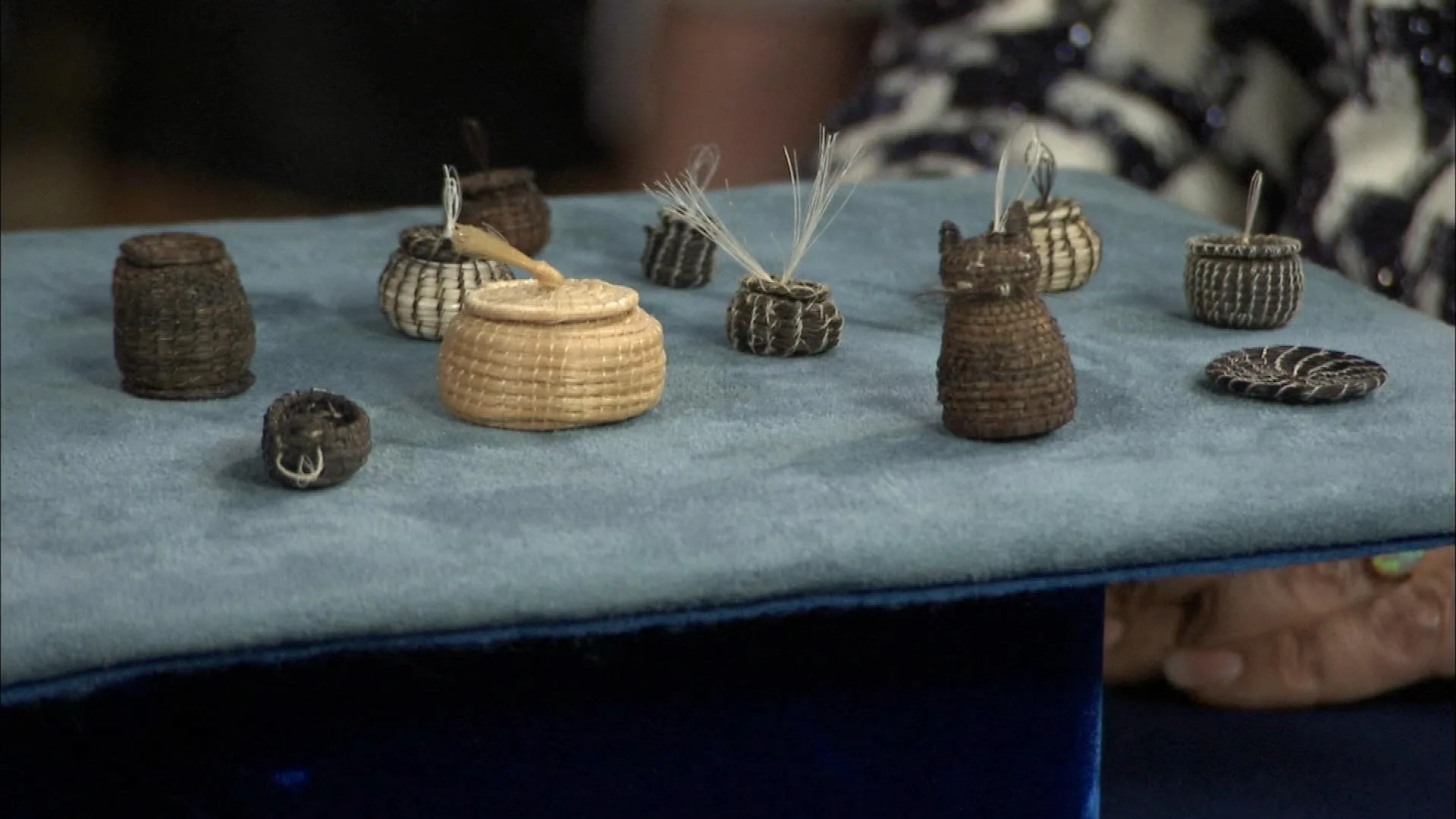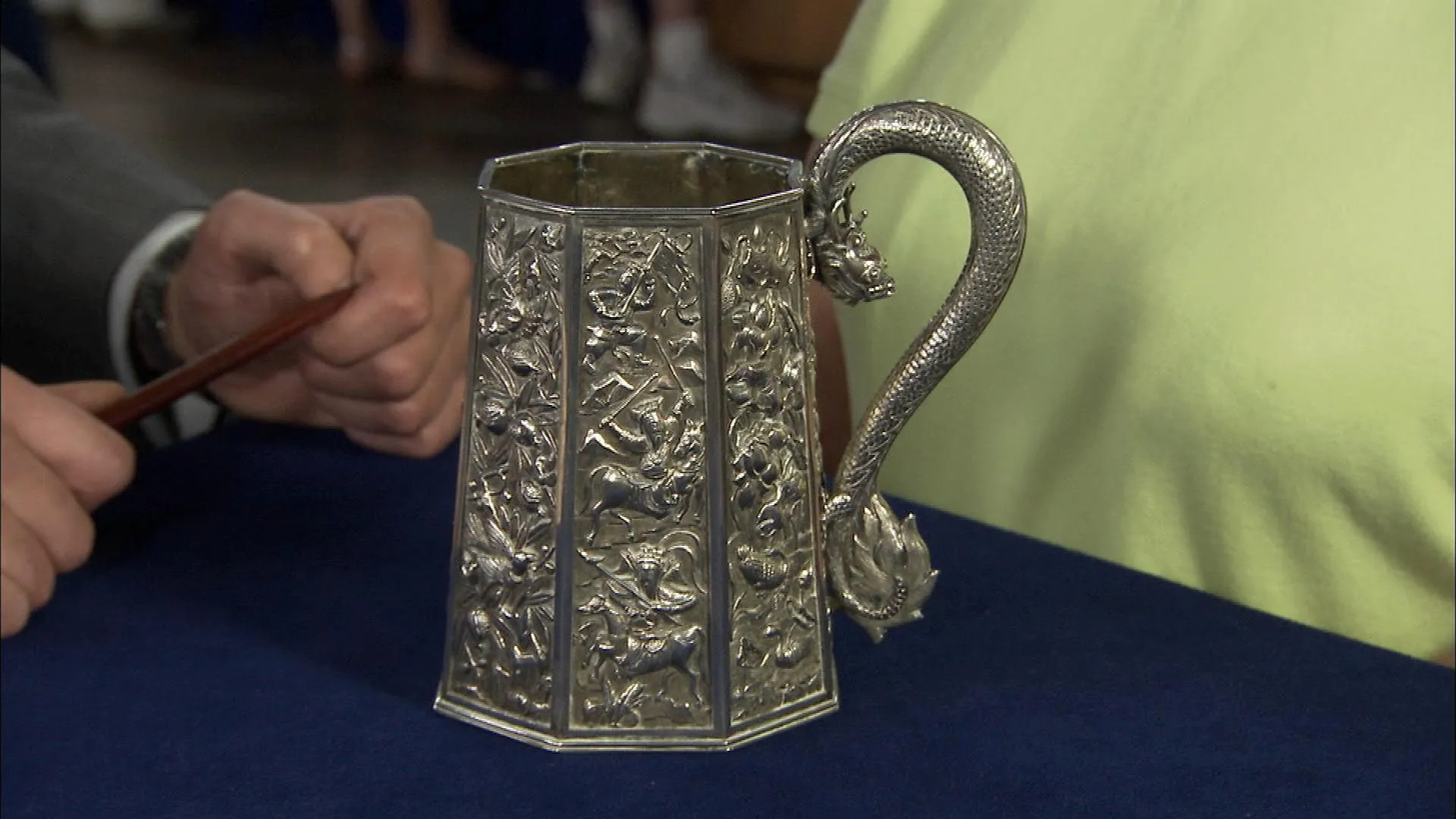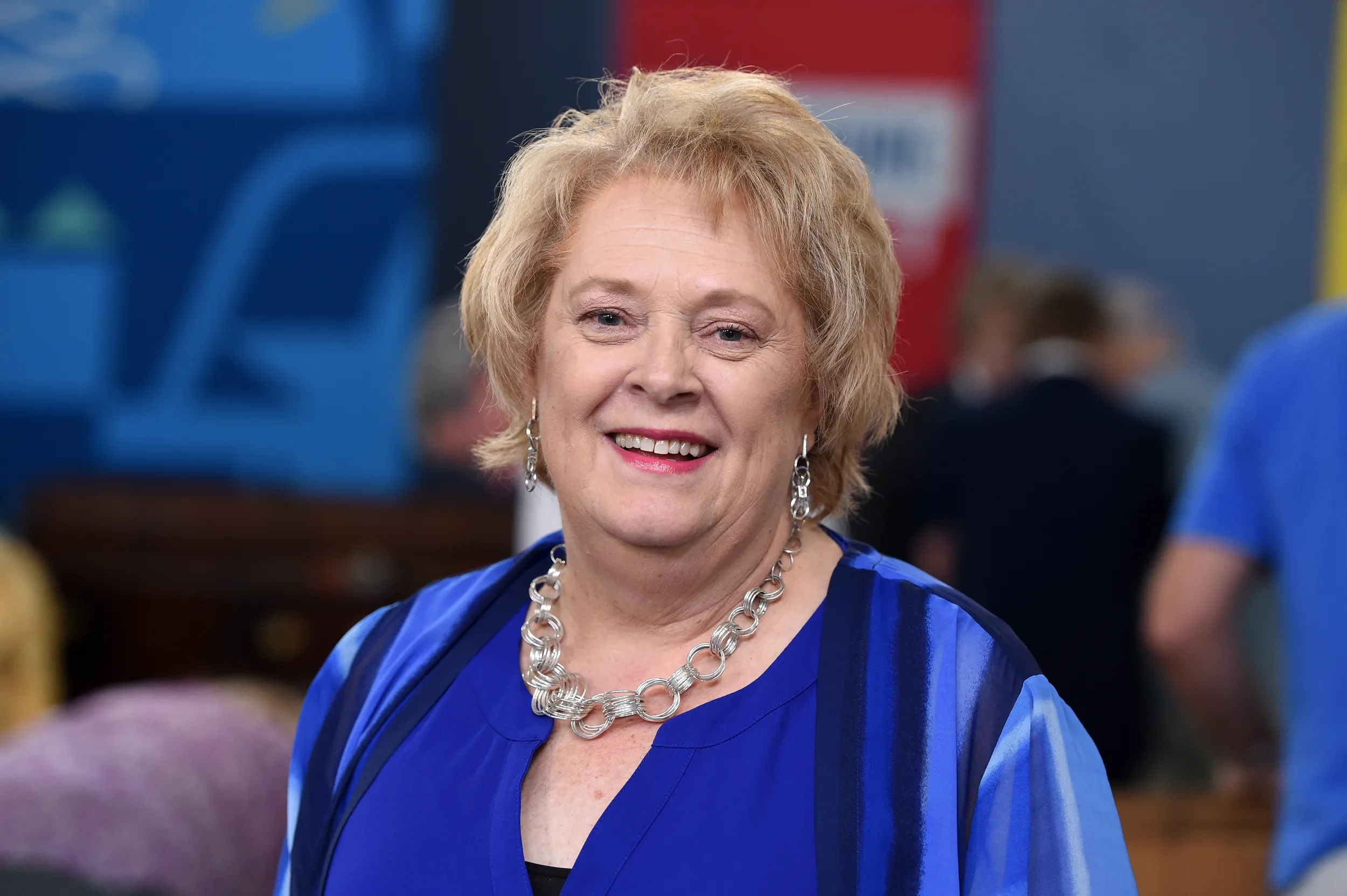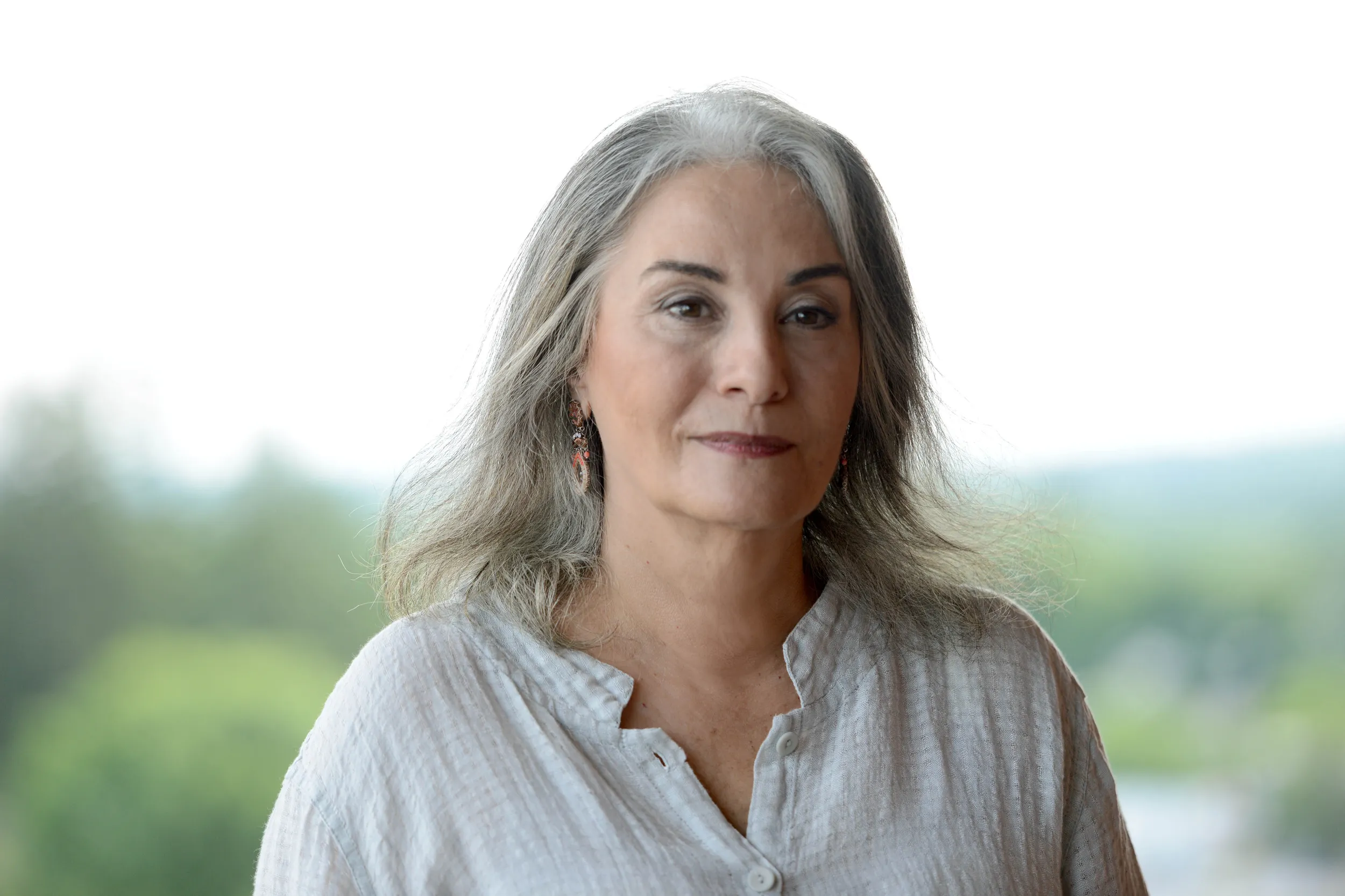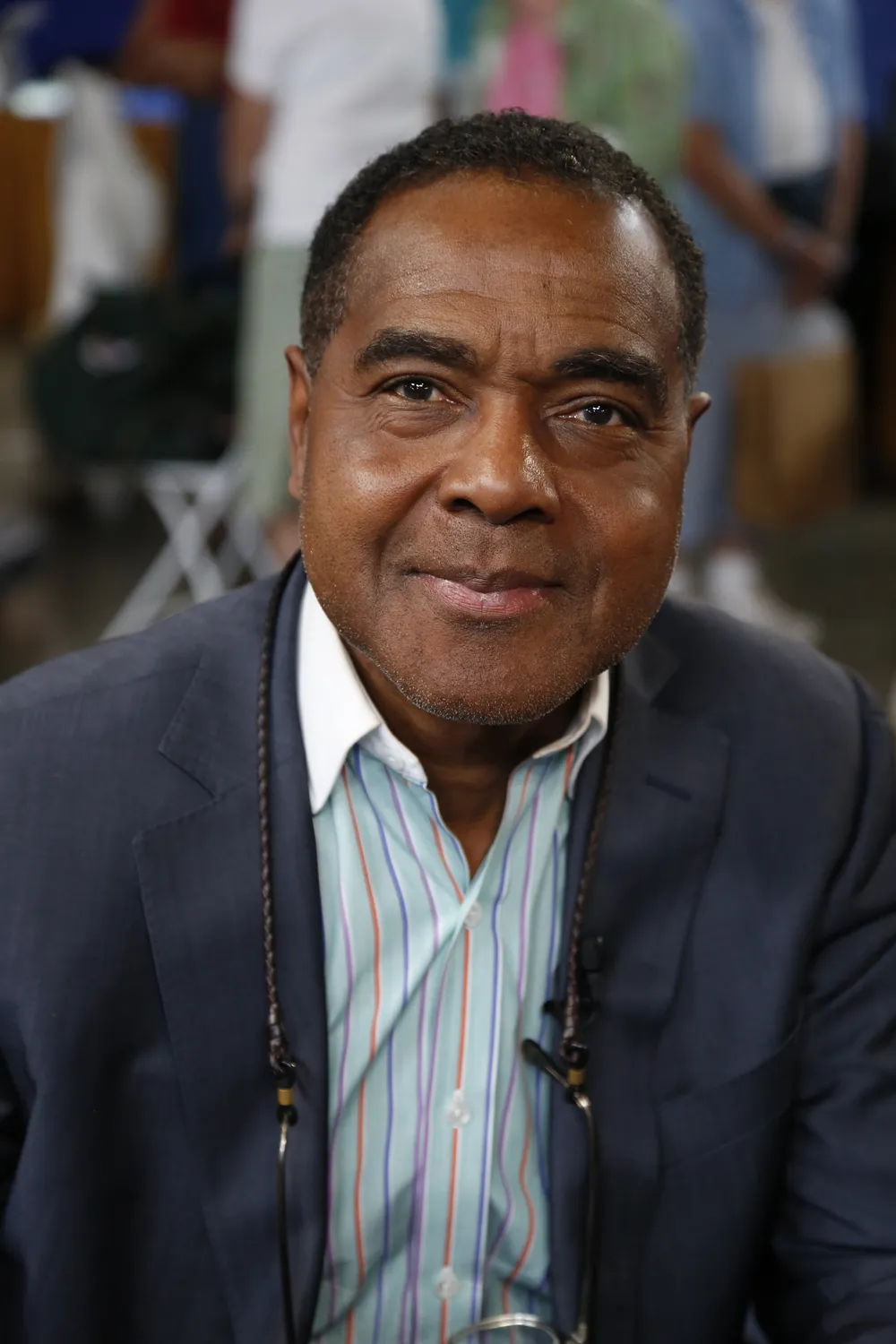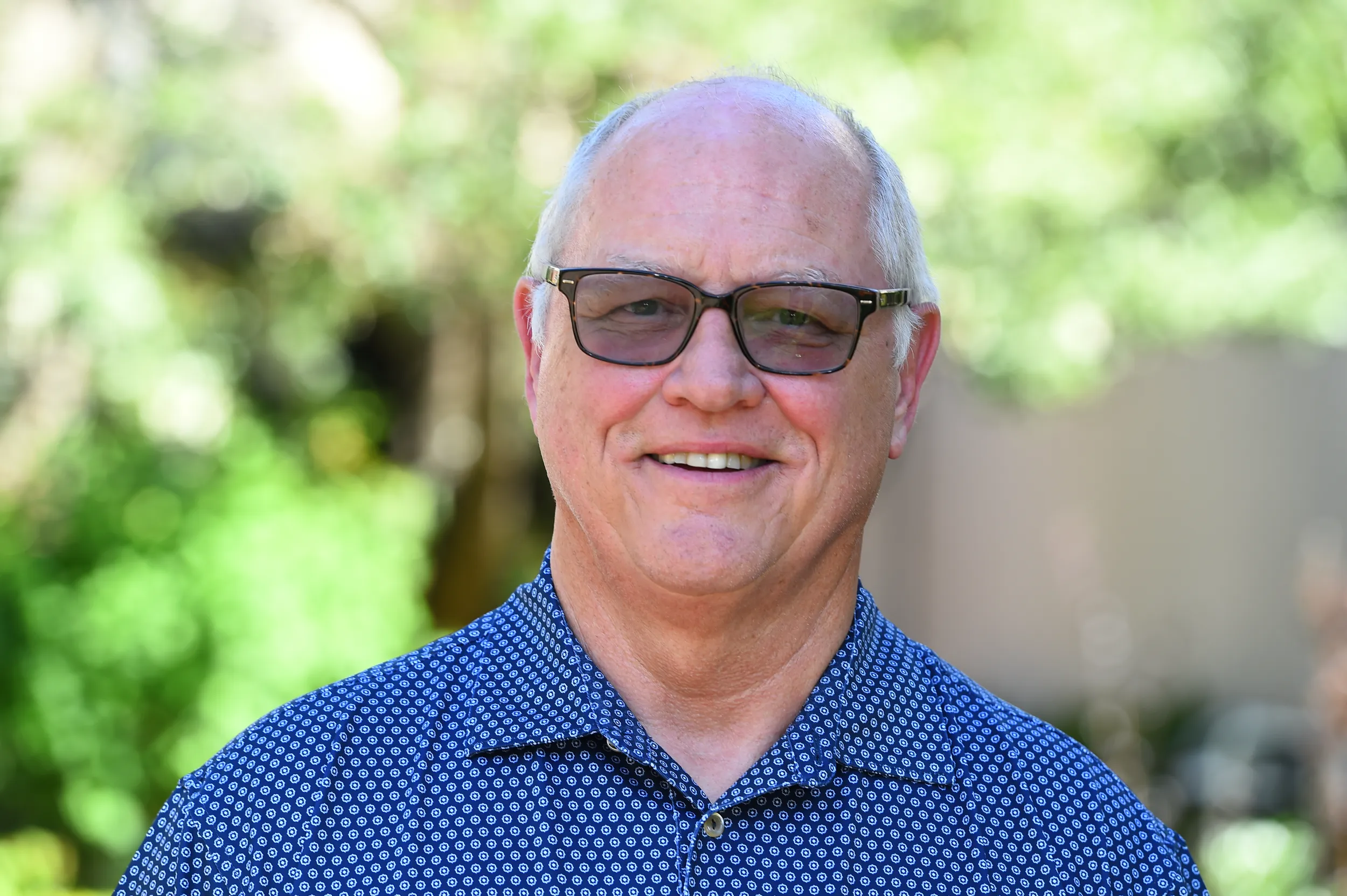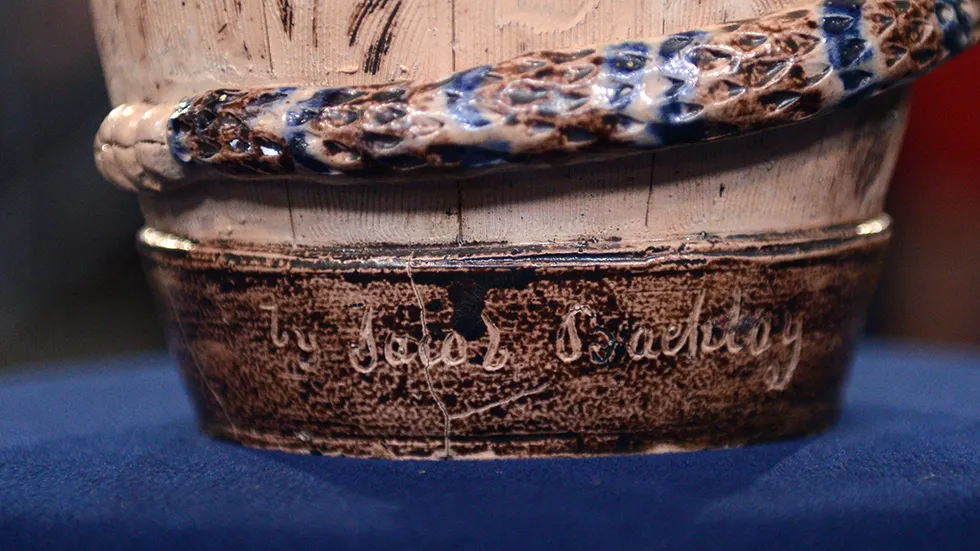WALBERG: Antiques Roadshow found some big treasures in Little Rock, Arkansas.
APPRAISER: There are a lot of photographers who covered the jazz era, but they didn't have all of those people sign their photographs.
GUEST: You are a goofy guy!
APPRAISER: Thank you, I've heard that before.
GUEST: I know you have, but...
WALBERG: Antiques Roadshow was graciously welcomed at the Arkansas governor's mansion in Little Rock. In the state dining room, we admired this silver service that was used aboard the battleship USS Arkansas. A persistent but discredited legend says Arkansas children donated 3,000 silver coins for its creation. Back at the Roadshow, work by a legendary American author was in the spotlight. Take a look.
GUEST: I brought an original magazine manuscript by Truman Capote. And I think it may well have been the last thing he wrote. For many years, I was the articles editor of Playboy magazine.
APPRAISER: Nice.
GUEST: I used to call myself the rationale editor, because everybody says they buy it for the articles, but in fact, in that capacity, I edited a lot of great writers: Norman Mailer and Kurt Vonnegut and E. L. Doctorow, who just died, and Capote, and many others. In the fall of 1983, I assigned Capote to write a memoir of his friendship with Tennessee Williams. We were anticipating this. This was going to be the lead story in Playboy's 30th anniversary issue in January of '84. The piece came in and Capote had called me and told me he writes in longhand, and he wanted me to have this manuscript for myself. Of course, when it came in, we had to retype it for the use of the magazine. The bad thing about it was, it was horrible.
APPRAISER: Horrible?
GUEST: Horrible, I mean, you know, and it's hard to...
APPRAISER: That's the editor in you? (laughs)
GUEST: That’s the editor- That was my job, being the editor, and yes, we needed his name for our cover line in the January issue. I worked up my courage to tell him I needed a rewrite, but we had a very sort of funny conversation. He always ended every conversation with me as "okey dokey, Mr. Morgan," so anyway.
APPRAISER: That's a good Capote.
GUEST: So, I asked him to revise it, and he said he was really sick. I didn't realize he was sick at this time.
APPRAISER: Right.
GUEST: Again, this is fall of '83, and so he asked me if I could revise it for him, and I said, well, I don't know what your relationship with Tennessee Williams was like. So, not going to reject this no matter what, I said, why don't we do this: We'll have some telephone conversations and I'll record them and you'll tell me stories, and he was much looser in his stories than he is when he sat down to write this.
APPRAISER: Oh I bet.
GUEST: So, that's what happened, we did about three nights running and he told me great stories and the magazine piece was published in the January issue.
APPRAISER: Fantastic. And things like longhand manuscripts are becoming harder and harder to come by, from the great authors of the 20th century. They're all typing...
GUEST: They just email them in now.
APPRAISER: Yeah, and you said before, and it's true of Capote, he was a traditional writer in that he did write longhand, very distinctive handwriting.
GUEST: Right. Right.
APPRAISER: The minute I saw it, I was like, that's Capote, you could see it a block away.
GUEST: So you knew it, yeah.
APPRAISER: And right away, he's talking about the opening of Streetcar Named Desire, he's talking about Blanche.
GUEST: Right, yeah.
APPRAISER: For him to be writing about a great writer is content that, for us, is very exciting. So, first rounds mean a lot, first drafts mean a lot
GUEST: Yeah.
APPRAISER: As imperfect as they are. And in fact, they probably mean more if you scaled like a draft, the more perfect it would get from an editor's point of view, might be the least interesting from ours. So, in this case, and I compared with what we could find of other manuscript material that have come up from Capote, and it's not a lot
GUEST: Yeah.
APPRAISER: I would safely auction estimate the manuscript at $20,000 to $30,000.
GUEST: Wow! Well, I'm glad I kept it in my lockbox all these years.
APPRAISER: And it’s fantastic, I'm glad you did, too.
GUEST: This piece was one of a pair that was in my great-grandparents' home. My grandmother was the older daughter, she got one, and the son got another, and I just thought it was such a beautiful piece, I wondered what the origin was and what you could tell me about it.
APPRAISER: I take it your family was rather affluent.
GUEST: Well, we're not anymore! (both chuckle) Whatever valuables are left are all in furniture.
APPRAISER: Okay, it's a very elaborate cabinet. Its sole purpose is basically to display works of art. So it could go into a parlor. I'd typically call it a parlor cabinet. We can see by the decoration, it has a combination of gilt incise, ebony, walnut, burl walnut, and a marquetry panel-- all traits that are not just generic cabinet forms. These are motifs and decorations that would have been applied by a cabinetmaker. And when we open the front door, we can see that it's lined with bird's-eye maple. Again, another hallmark of a cabinetmaker, particularly those affiliated with New York cabinetmakers. And when we take a look at the back, we can see again that that's accented once more with dovetails and paneled backs. So it has all the hallmarks of a New York-made cabinet piece. But since there's 5,000 cabinetmakers active in New York, oftentimes we're just left with... well, it resembles the work of this maker or that maker.
GUEST: Uh-huh.
APPRAISER: In this case, we know exactly who made it. J. Ziegler. J. Ziegler was a very obscure maker today, but he was a prominent maker in his day.
GUEST: Uh-huh.
APPRAISER: He started business in New York around 1850, and he concluded about 1878, but post-Civil War furniture, basically 1865 to '71, was sort of his production. And he had a gentleman working for him by the name of William Baumgarten, and William Baumgarten left him in 1871 to go to work for a firm called Herter Brothers, who was the leading decorator, and I think that really set his demise. So he was competing with the most sophisticated interior decorators and cabinetmakers active in New York at that time period. So what we have is a piece of furniture that is very historical, and that it gives us a record of his work and there are very few examples of his work. Sometimes history doesn't always correspond to its value, however. Auction estimate would be $3,000 to $5,000.
GUEST: Okay.
APPRAISER: And certainly could go more than that. I would consider it a conservative estimate.
GUEST: Well, that's excellent. Is it more valuable as a pair, if you had both of them?
APPRAISER: It would be, and I think that's a very uncommon thing. If we had the pair offered at auction, we'd probably put $8,000 to $12,000 on them as a pair.
GUEST: Okay.
APPRAISER: You have the very, very pretty flame cross-hatching, and it's probably about 1910.
APPRAISER: Made of pine, really interestingly carved. You can see here this nice backrest. In a good antique store, I'd expect to see maybe $400 or $500.
APPRAISER: So I'm thinking... $600 to $800. I don't know what you were thinking.
GUEST: I wasn't thinking anything. I was thinking I paid 15 bucks for it.
GUEST: We got this after my dad passed away. We had another Camark vase in our home as I was growing up, and so when we found this in the box, we decided to keep it.
APPRAISER: It's made in Camden, Arkansas, it's local pottery. Jack Carnes started Camark about 1926, hoping to find a use for Arkansas clay. He sent quite a bit of it to a fellow named John Lessell in Ohio. John Lessell had worked for a number of potteries up there, including Weller and Owens, and John found that he could make good pottery with Arkansas clay. Decorated some pieces in this type of glazing and sent them back here, and they were some of the original stuff sold at Camark. The idea was John Lessell was going to come back and work for Camark. He died in 1926.
GUEST: Wow.
APPRAISER: But his wife and the people who had worked with him making these luster glazes came down to work in Camden for Camark, and this is a nice example of a Lessell-type luster glaze, and you'll notice the name on it: Le-Camark. That means it was made locally, not in Ohio. This probably dates from '27, maybe '28. This is what collectors of Arkansas pottery are looking for. A piece like this, probably valued, at auction, at about $1,000 to $1,500.
GUEST: Wow, that's surprising.
GUEST: It has been in our family for at least three and probably four generations. I know that my grandfather was a devoted collector, and that's really about all I know about it, other than it's always been in our family.
APPRAISER: Well, it's a beautiful painting, and Julian Onderdonk is known as one of Texas's most famous artists, and he's famous, very well known, very prolific, for his beautiful paintings of the Texas landscape with bluebonnet flowers. What people forget about him is that he studied in New York and studied with William Merritt Chase.
GUEST: Oh.
APPRAISER: The wonderful American impressionist artist, who had a studio in Long Island.
GUEST: Oh, uh-huh.
APPRAISER: And he was probably studying with him turn of the century, and these little wonderful plein air sketches were done 1908, 1909. It's a beautiful image. One of the things we always talk about on the Roadshow is that you want to stay sort of on topic. And ideally, the "on topic" for Onderdonk is Texas themes. But a really, really close second is his Long Island scenes, because they're early, they're Long Island at a beautiful time. They're very Chase-like. In terms of condition, we have a little issue in that it has been restored.
GUEST: Oh!
APPRAISER: It has been lined, and one of the things that we still see in the sky is a craquelure pattern, and what one hopes to have happen after restoration is that the cracks are leveled.
GUEST: Oh.
APPRAISER: That said, have any idea what he paid for it, what anyone paid for it?
GUEST: No, no, no, it has been on the walls of various family members my whole life.
APPRAISER: Well, I'm thinking 1920, let's say they bought it around his death, 1920, a few hundred dollars, perhaps. Retail, I'd be valuing the painting at $35,000.
GUEST: You're kidding. (laughing) Oh, my gosh.
APPRAISER: Yes.
GUEST: Wow!
GUEST: This was from my father's estate. He collected art for many years, and he got it from his next-door neighbor who was an art dealer, who was French. And so I think it's a French statue.
APPRAISER: Uh-huh.
GUEST: But I have no idea what he paid for it.
APPRAISER: And do you know how long ago that was?
GUEST: It would have been in the late '60s or early '70s.
APPRAISER: It's interesting because the late '60s, early '70s are just when this market started to take off.
GUEST: Oh, okay.
APPRAISER: This is by an artist named Demétre Chiparus. He was actually Romanian, but he studied in France, and he exhibited quite a bit in France. The piece is very clearly signed by him. And the sculpture itself is bronze, and then it has this wonderful paint on it. We call this cold-painted. So it's actually painted with oil paints, it's not a patina, and then this base is made out of different types of onyx. And I think it's a wonderful combination of this very elaborate dress she's wearing with this very, very colorful base. Chiparus is very much influenced by contemporary ballet, dance, theater, the movies in the '20s. This is from the '20s, '30s. All these things were happening. In Paris there were the Ballets Russes, which is very famous, the Folies Bergère, so most of his sculptures deal with various dancers in these amazing, exotic costumes. I mean, it's really wonderful, and the great pose. Here, the expression on her face is just wonderful. All over, it's just a great looking piece. What's interesting about this piece by Chiparus is that we see a lot of these at the Antiques Roadshow.
GUEST: Yes.
APPRAISER: In fact, we probably see more Chiparus than any other sculptor, and almost every Chiparus we see is fake. Because they were so popular in the 1960s and 1970s, and since the value has increased, they make copies, reproductions of them.
GUEST: Yes.
APPRAISER: So they'll take an old bronze, and they'll make a cast of that and from that cast they'll make another cast. And it does not have the kind of detail that you see in these original sculptures. And also the French were real masters at casting bronze, and the foundry works closely with the artist, so the artist can direct how he wants it cast, what he wants it to look like. It's really a wonderful piece, and any idea of the value?
GUEST: I have no idea.
APPRAISER: You have no idea?
GUEST: No.
APPRAISER: Well, in a retail setting, this would probably be between $6,000 and $8,000.
GUEST: Okay, that's nice.
GUEST: It is an engagement ring from my husband.
APPRAISER: I hope you said yes, right?
GUEST: Oh, I said, oh, yes, yes, I did.
APPRAISER: Have you ever had the ring appraised before?
GUEST: I have had the ring appraised, but the appraiser was uncertain about the actual price because of the origin. She was confusing it maybe with a Cartier and wasn't sure because of the markings. It was handed down from his great- or grand-aunt Lottie.
APPRAISER: Wow, you know, when I look at this photo, besides being beautiful and sort of a bon vivant, who else would have worn a ring like that? Because this is a ring that sort of is not the norm for shape. When you think of classic engagement rings, you think of round, you think of emerald-cut of this period. And you think, maybe, what is the shape of this ring? It really is what I call a fat pear.
GUEST: Really?
APPRAISER: Fat pears I love, because they read voluptuous. They're kind of a sexy stone. This is an old European cut, and when I tried to measure it, I said, do I use a round formula, do I use a pear shape, so it was kind of tricky, so I came up with a weight, by formula, as approximately five carats.
GUEST: Whoa!
APPRAISER: Yeah, that's a nice, healthy size for a diamond. And then the next thing we did was we kind of tried to judge what color is it? Very hard to judge color in the mounting. It's not a white stone, but it's not really yellow, so it's hovering between white and yellow, but reading much more yellow, but not yellow-yellow. But it makes that a very soft, sumptuous color. It's pale, it's alluring, it's almost like the woman in this photo.
GUEST: Yes.
APPRAISER: I tried to see who could have made it, because when you look at this mounting, it didn't have the signature that I was hoping for, like Cartier, you know, one of the big names.
GUEST: Really?
APPRAISER: But it had a maker, K and F and Company. Tried to do some research, could not come up with anyone. But it's definitely American, and I would say probably made in New York, Boston, Philadelphia. It's very sophisticated. It's pure Art Deco, I would date it circa 1920. It doesn't have a lot of wear, just one little chip around the bezel.
GUEST: Not bad to be that old, is it?
APPRAISER: Not bad, I wish we had no chips.
GUEST: Oh, my goodness.
APPRAISER: I love it, I love the ring, I love the whole feeling of it, and very hard to come up with a comparable and give you a price. I think you're going to have to spend at least $55,000 to $65,000.
GUEST: Uh-uh! Oh, my word!
APPRAISER: I can't imagine... And who would have it? You'd have to go to some fancy shop...
GUEST: Oh, my goodness!
APPRAISER:…that carries esoteric, one-of-a-kind diamonds. You can't comp this out. So I would say a retail value is between $55,000 and $65,000.
GUEST: That is incredible. Thank you so much.
APPRAISER: Oh, thanks for bringing it in, and I love the photo, I love the whole feeling of it.
GUEST: Oh, you're welcome.
GUEST: It's not a million dollars, it's worth $200. It's over $50!
GUEST: My sister that's 87 collected them and she gave them to me. Thank you.
APPRAISER: Each section tells a story, but there's a flow to it that's very consistent with murals so it's a great piece, so thank you for bringing it in.
GUEST: You bet.
GUEST: My parents moved to Hamilton, Illinois, and my dad got a job at Montgomery Ward Store, and while he was working there, he bought this guitar for me. I believe it was for my birthday, they bought it for me, and when he bought the amplifier that goes with it, he had to get a used one and he apologized that the amplifier had to be used because he'd spent all his money for the guitar.
APPRAISER: Now do you remember about what year that was?
GUEST: It was either '55 or '56.
APPRAISER: And did you used to play in any kind of a band with it?
GUEST: No, no I kind of taught myself to play a few songs, and I really never did get very good at it, because I like to work on a farm with cattle and stuff. I was always mashing my fingers, you know, so I just never did really get good at it.
APPRAISER: So as a result, the guitar never really got played a whole lot, so it's in what we would call almost-new condition. It's called the Les Paul TV special, and they painted it this certain color so that it would show up well on the old black-and-white TV sets, but it is indeed a 1956 with a single cut-away, and it was sold as an economy guitar when it was new. A Les Paul TV special in this condition will have a retail value of about $11,000 to $12,000.
GUEST: That's good.
APPRAISER: That's good.
APPRAISER: My dad worked for NASA during the space race, and he was a technical illustrator, but every once in a while he got to do something fun, and when Michael Collins came to him and said, "We want a mission patch for Apollo 11," that's what he came up with.
APPRAISER: Michael Collins, who was the pilot for the Apollo 11 mission, came up with kind of the original germ of the design, the concept of the design.
GUEST: Michael Collins said what they want is the eagle, you know, landing on the moon, so he said, "I want an eagle in it, and I want the moon, and I want the earth in the background." They sent it to Washington and they said, "that's really almost perfect," and he goes, "Almost?" He says, "Yeah, except for the talons." He said, "We come in peace, we want a friendly eagle." He goes, "It's a bird of prey." So then what he did is came up with the final one, put the olive branch in the talons, he made it as friendly as he could make it, and that's what they wore to the moon.
APPRAISER: Now in Michael Collins' autobiography, he talks about the creation of the patch. He talks about looking up different pictures of birds and trying to find a bald eagle, and he found a picture of a bald eagle coming in for a landing with the talons extended, and he thought, it's coming in for a landing, that's a really cool image. And so he took some tracing paper and drew over the eagle, and said, "This is the version that I like," and he later commented on it, once they moved the olive branch down to the feet, he's like, "Well, I hope he drops the olive branch before he comes in for his landing." It looks like that these are the exact same painting. Do you know, did he paint in oils or watercolor?
GUEST: I believe it was in oil. This are the same paintings. What he did was he painted over, so when he painted over the talons and the olive branch, he took a picture of it before he changed it, and as far as I know, this is the only photograph of this version of it. I mean there may be one at NASA but I've never seen one.
APPRAISER: Now, right here we have the final version of the patch with the friendlier eagle…
GUEST: Yeah.
APPRAISER: …the olive branch in the claws, signed by Neil Armstrong, Michael Collins, and Buzz Aldrin. Have you ever had these evaluated?
GUEST: I never have. My dad, he's retired and actually, you know, living in a retirement area, and about four or five years ago, he started sending me stuff, and so I've just got stacks of the stuff, and I just pulled these out and brought them to the Roadshow to see what you guys thought.
APPRAISER: Well, having the photograph of your father actually working on the piece, having a signed photograph of the final version of the Apollo patch, we give a fair auction estimate of around $3,000 to $5,000 for this collection.
GUEST: Wow, wow, thank you very much. That's amazing.
APPRAISER: The big question is, does your father still have the original painting?
GUEST: He doesn't know where it is, doesn't know where it is.
APPRAISER: Wow.
GUEST: Uh, yeah, after 40, 50 years...
APPRAISER: Well, because if we look closely on this one, you can see a couple of little changes. The A from the “APOLLO” and a couple of letters were moved slightly over and painted over. There's some other little changes here and there where you can see some overpainting done, so it'd be really fascinating to see how many other minor tweaks and changes were made over the design of the patch. If we could find the original art for that, we estimate, at auction, it would be between $20,000 and $30,000.
GUEST: Seriously? Wow, wow, unbelievable. Wow, I never thought, but that's amazing.
GUEST: My mother-in-law collected Asian pottery and Asian plates, and she gave this piece to my husband and I. That's really about all I know about it. I believe it’s-
APPRAISER: Do you know where she got it?
GUEST: I do not, I do not. She traveled a lot and she collected things wherever. She bought them at different estate sales, and wherever she would come across them.
APPRAISER: Do you have any idea how old this is?
GUEST: No, I don't.
APPRAISER: Well, the top and the bottom, the lid here and the stand, those are 18th century.
GUEST: Okay.
APPRAISER: Probably during the Ch'ien-Lung reign, they were made between like 1736 and 1796. The jade finial on the top is Ming period, which is 1368 to 1644. But the piece it's enclosing is Longquan celadon, and this piece was made in, probably, in the 13th century. Okay. Around 1250 or so, and one of the things about it is, it's of the best color for Longquan, it's that... they call it kingfisher's feather color, that bluish green color
GUEST: Yes, yes.
APPRAISER: And the decoration is mallow flowers that are on it. And it would have been filled with sand.
GUEST: Filled with sand? Wow.
APPRAISER: Yeah, and they would burn the incense on the sand.
GUEST: Okay, interesting.
APPRAISER: This is what the Chinese call hongmu, red wood. The carvings here are a thing called ruyi, and the words ruyi in Chinese mean "as you wish."
GUEST: Okay.
APPRAISER: It's an emblem that you're hospitable and receptive to people. The wood was probably a hundred years old by the time this was made.
GUEST: Oh, wow.
APPRAISER: You know, in the 18th century. But magnificent. This is carved like a lotus pad, the base. This is a celadon stoneware that this material is made out of, virtually porcelain, but just a little less fired than that.
GUEST: Okay.
APPRAISER: A really lively carving.
GUEST: It is.
APPRAISER: It does have some condition problems. It has a few hairline cracks, but that's more or less to be expected on something that's this age. But the presentation is really magnificent on this thing. In its present condition, at auction, we would expect this to sell between $8,000 to $10,000.
GUEST: Okay, wow.
APPRAISER: And it's just a wonderful piece, absolutely typical Longquan.
GUEST: Wonderful.
APPRAISER: Really fine quality.
GUEST: Yes, well, she'll be delighted to know.
GUEST: I know that it is a 17th century map of Maryland. It was a gift to my father, back in 1954, from his brother, who bought it in London on his way back from the Korean War.
APPRAISER: Okay, it is 17th century, it's from 1671. I ought to help people by putting it into perspective, because it really doesn't look quite like Maryland. It does say up here, "Nova tabla," which is "new map" of land of Maria, or Maryland, but what's strange about it?
GUEST: This part isn't north.
APPRAISER: Right, north is not up! Down here, you can see there's a compass rose, and north is to this direction. Putting north to the top of a map is a convention that we've become very used to, but actually, in the 17th century and before, it was tended to do that, but sometimes for various reasons, they would change it. And this is actually oriented to the west, because this is how you would look at the land when you arrived from overseas.
GUEST: From a ship-- okay.
APPRAISER: You'd be sailing in a ship, and you'd be coming up this way, so that it was laid out in front of you sort of left to right.
GUEST: Okay.
APPRAISER: And so because that's how the people from Europe approached Maryland, that's how they laid out the map.
GUEST: Okay.
APPRAISER: And you can see, here's the Chesapeake Bay running to the north here. So Maryland is basically in this area in here, so that puts it into context.
GUEST: Right.
APPRAISER: As it happens, this is really one of the very earliest maps of Maryland.
GUEST: Oh!
APPRAISER: It is the second version of what's called the Lord Baltimore Map. And Cecil Calvert was Lord Baltimore who was a proprietor of Maryland, and this is his crest right here.
GUEST: Right.
APPRAISER: And this is a second version, it's based on a map from 1635, which was the first version…
GUEST: Oh.
APPRAISER: …which is the first map of Maryland. That one is very, very rare, so this is actually the first obtainable map of Maryland. 17th century maps of any American colony are very rare, and this is quite a rare map. It was done by a man named John Ogilby, and he did update the map. First of all, he moved the border of... this is the border of Maryland, and on the earlier map it was a little too far south. He also added the counties, which was new, and one of the interesting things is, he probably had a connection with Cecil Calvert, because it actually names Cecil County, which is right here, and that wasn't created until three years after this map appeared. So it's likely he got that information and the other information from Lord Baltimore.
GUEST: Okay!
APPRAISER: So he used the first map of Maryland, he updated it with privileged information. So the scarcity, the connection with the history, that's all great, great stuff. American Colonial maps are very, very popular. Did you have any idea of what the value would be?
GUEST: Hmm, no. The only value I know is the six pounds my uncle paid for it in 1954.
APPRAISER: Well, it's worth considerably more than that. Today in the market, this is a map that, in a retail environment, sells for about $8,500.
GUEST: Whoa!
APPRAISER: Yeah, it's a great map, and I was absolutely thrilled when you brought it in.
GUEST: Well, thank you very much.
APPRAISER: When they put the U.S. in them, it's for a higher grade officer, and these were privately purchased, so could have went to either side. Probably worth somewhere in the $300 range.
GUEST: Okay, which is about what I paid for it.
GUEST: We found a painting in the bottom of a cedar closet. I inherited a house and its contents from an elderly gentleman about three years ago. It's a Blanche Lazzell and that's all that I know about it.
APPRAISER: You're exactly right. The signature of the artist is right there, Blanche Lazzell, and it's also dated 1926. Blanche Lazzell is a Provincetown artist. She worked with several artists who had fled World War I. This collective of artists included women and men and many of them were studying Japanese woodblock prints, and the method that they innovated was white-line woodblock printing. And that method involved printing that left white outlines around the image area, and that's one of the things that she's best known for. What you have here today is a little bit different. This is a monoprint.And a monoprint is something that straddles the medium between painting and print. And it is done by taking a surface like glass and then the artist will paint on it freehand and then take the paper and press it against the surface. It's a unique image, usually. And that's why it looks so painterly where you can see the artist's brushstrokes. So it looks and feels much more like the artist's hand than perhaps a woodblock print would, which can be inked several times and several images can be made of the same thing. So chances are this is the only one of its kind. But because it is pressed against a surface, that's why we use the word "print." "Mono" being one or singular.
GUEST: Mm-hmm.
APPRAISER: In the auction market, I would probably estimate it to bring between $6,000 and $10,000.
GUEST: Wow! Not so ugly now. My husband said it was ugly. (laughs)
GUEST: Well, it came from my great-great-grandmother. We call it a whiskey crock, really don't know what it is. It just was passed down from generation to generation. And I wound up with it. I'm the oldest child in my family.
APPRAISER: Okay.
GUEST: I always thought it was just a piece of art. I mean I didn't think it was anything that was functional, that was used for anything, I just... something to look at.
APPRAISER: What you have is what's known as a temperance jug.
GUEST: A temperance jug.
APPRAISER: A temperance jug. And during the Victorian period, when they were kind of prudish about things, the movement against alcohol consumption was full steam ahead by the 1870s, 1880s. So what you have here is a salt-glazed stoneware temperance keg. There are a number of jugs with snakes, and with serpents, and with all kinds of things. The bottom line was they were meant to say that alcohol was bad for you. And in this case, the serpent that you see here-- which is actually a rattlesnake, if you look down on the bottom you'll notice it's a rattlesnake-- that guy goes all the way up in this beautiful salt glaze with cobalt blue and Albany slip. It comes all the way up to the top where he is looking in that hole. And if you look at the top, he's looking in that hole to see how much is in there. And on the front here incised-- so cut in freehand-- it says "A whisky gauger." And now down at the bottom here, it says-- it's of course incised, which you've seen-- "By Jacob," and it's very hard to read, but it looks like "B-A-C-K," and then "L-A-Y." Now I searched and searched in the time that we had here, and I could not see his name under potters. So what do you think?
GUEST: $50.
APPRAISER: No, no. You got to think more than that. Raise it a little bit.
GUEST: $200.
APPRAISER: We're playing poker. $200. I'll up you. I can't... okay, you bet $200, I'll up you $8,000.
GUEST: You've got to be kidding me.
APPRAISER: No.
GUEST: $8,000?
APPRAISER: An auction estimate on this piece would be $8,000 to $12,000.
GUEST: Wow. I did not expect that. (both laugh) Absolutely.
GUEST: This desk was carved by my great-grandmother, Blanche, probably just before the turn of the century. Blanche was a renaissance woman, she traveled all over the world, and had time to do a number of wood carvings. We have several of the pieces, but this is a real favorite because the desk has been in the family for years.
APPRAISER: So where was your grandmother living when she made this?
GUEST: Born and raised and lived in Green Castle, Indiana.
APPRAISER: Okay.
GUEST: And I'm told she entered it in the Indiana Fair and won a number of blue ribbons, with her carvings there as well.
APPRAISER: I can see why.
GUEST: Yeah.
APPRAISER: When I first looked at the information about it and realized that it was made by a woman, one question I had to ask you was: are you descended from a line of strong women?
GUEST: (laughing) I would say yes. I would say yes.
APPRAISER: Because this is a really gutsy project for a woman in the 1890s. Did she go to any schools to study art or anything?
GUEST: Absolutely not. As a matter of fact, she was a lady of leisure, really. She did china paintings, she traveled the world, brought some beautiful pieces back from Europe, but did a number of very nice, big strong pieces just like this.
APPRAISER: That's the thing that attracted me to this right off the bat. When you first walk up to it and you look at it, it makes you think of something maybe that has an Oriental influence. And then when you start looking closer, you see that the carving is more from the Art Nouveau period. That was a time when there was interest in decorative arts, and there were a lot of very nice floral and sinuous lines. My guess is she knew somebody that was a cabinetmaker that could make the desk and then she did all the embellishments. It's just eye candy from the top to the bottom. I love the way she did the splashboard up top there with that little offset over on the side. And my favorite part of it probably is the slant lid. To me that has the boldest carving. And the thing that blows your mind when you start looking at something like this, when she started out with this, she had a piece of walnut-- black walnut-- and it was a solid board. She probably sketched the designs on it, and then she took a chisel and knives, and she also probably had a little stippling punch like you work with leather. Because once she got it down to where the background was going to be, she put all those little stipple marks in it. Those are just like little small holes punched.
GUEST: Right, right.
APPRAISER: And they... she did that to give it more architectural detail. Those are still the original pulls on there. What she did was she created her artistic vision of an Art Nouveau style desk. And in my mind, the quality of it and the way that it's done, it's really... it's almost like a museum piece. I think there's a lot of interest in female artists from that time period, and for insurance purposes,I would give this a value of $5,000.
GUEST: Oh, that's wonderful, wonderful.
GUEST: $50 to $100, so I guess I played with it too much as a child. (laughs)
APPRAISER: And you've got Mickey. Nice to meet you, Mickey. (laughter)
GUEST: We saw so many in Baton Rouge because of the French influence in Louisiana. But this is very attractive. I think it's about a $2,000 clock.
GUEST: My grandparents lived in Japan for about ten years during the Occupation. And right before they left, they traveled the world. And one of their trips while they were in Japan was to China. This is one of the things that she brought back from her travels. And I always loved horses and so she left it to me.
APPRAISER: The horses are absolutely terrific. These are made of silver.
GUEST: All right.
APPRAISER: Probably a high grade of silver. The detail is really pretty wonderful. And there was a tradition in Japan of metalworking at such a high level. And that emanated from training that a lot of metal workers had with swords from the late Meiji period and following.
GUEST: Okay.
APPRAISER: And that's what we see here. So these date to the late 19th, early 20th century.
GUEST: Okay.
APPRAISER: They are Japanese. The detail extends even to the horseshoes on the feet. Right, wow. Now I'm going to take this down so we can see. The stand itself is also beautiful. And it's a type of Asian hardwood on which is a type of gilded gold lacquer that's been built up on the surface.
GUEST: Okay.
APPRAISER: Which is a very difficult technique to do.
GUEST: Oh, really?
APPRAISER: And it also is easily damaged. The fact that yours is in great shape helps the value.
GUEST: Oh, good, good.
APPRAISER: So I think in an auction sale today, these would make around $4,000 to $6,000.
GUEST: Oh, wow. Wow. That's great.
GUEST: Walter-- I think it's Ingram-- Anderson was a graphic artist in south Mississippi. His brother Peter had a pottery called Shearwater Pottery, and Walter was hired to decorate the pottery.
APPRAISER: I believe it's Walter Inglis. Rather than Ingram.
GUEST: Inglis, you're correct.
APPRAISER: But he actually studied at the Pennsylvania Academy of Fine Art, which is in Philadelphia.
GUEST: Okay.
APPRAISER: And did very well there to the extent that he was awarded the very prestigious Cresson Traveling Fellowship.
GUEST: Oh, neat.
APPRAISER: So he went off to Paris. Now, of course Paris was a hotbed of modernism at this time. I think it's very telling that actually he got more out of visiting the caves and the ancient cave paintings than he did out of modernism. And I think that influenced...
GUEST: Well, I can see that.
APPRAISER: Yeah, it says a lot about him, and really how his connection with nature and everything else because as you say, he was very much a visionary artist. There was very much a spiritual element to his work. How did you come by these? Could you tell us a little about that?
GUEST: This first piece was given to my father by his brother. It hung in my parents' home until my 50th birthday, and then was given to me by my father. The second piece, a nephew of mine had about maybe 20, 25 pieces and he contacted me first and said, "Would you be interested?" And we cherry-picked eight or nine pieces that we felt some affection for.
APPRAISER: And do you remember what you paid for it?
GUEST: I want to say somewhere between $800 and $1,200.
APPRAISER: Okay, this one was done in 1947 or thereabouts, I believe, yea.
GUEST: That's correct.
APPRAISER: And this one I suspect is later just stylistically, and also it's not quite as faded. We don't know exactly when it was done, but we could speculate maybe into the '50s possibly.
GUEST: I do not know.
APPRAISER: He died in the '60s I know, so yeah.
GUEST: Okay.
APPRAISER: And then of course the bowl.
GUEST: This piece was purchased by my parents down at Shearwater Pottery, and it was part of the gift my father gave me for my birthday.
APPRAISER: Well, let's start off with the bowl then. And I discussed it with one of our specialists in the ceramics table. And he said it's a nine out of a ten, basically.
GUEST: Well, that's nice to hear.
APPRAISER: In terms of quality. And he felt Anderson probably would have hand-painted it as well. At auction, felt that it would probably... he would estimate it around about $4,000 to $6,000.
GUEST: Well, my goodness, let's put some potted petunias in there.
APPRAISER: Well, not too sure about that.
GUEST: That really... I think that would make Walter smile.
APPRAISER: And then moving along to this one, which is this wonderful study of a crab, although it almost looks like some strange kind of mechanical apparatus.
GUEST: Well, you're right about that, yeah.
APPRAISER: Yeah, I just think it's got such a great intrinsic sense of design and line, and it's a lovely sepia ink drawing. Estimate on this, probably again around about $4,000 to $6,000.
GUEST: Well, that's shocking. That really is shocking because that's significantly more than we paid for it. Well, maybe ten years ago.
APPRAISER: Well, I think it's fair to say the market has moved on as well.
GUEST: Well, I haven't.
APPRAISER: So there's a lot of demand. (laughs)
GUEST: Well, joyful.
APPRAISER: And then of course we come to this one, which was your 50th birthday present, and pelicans. And of course in the Anderson pecking order-- excuse the pun-- pelicans are really what people tend to want. Now, this one does have some condition issues, you know.
GUEST: Oh, of course it does.
APPRAISER: As you tend to expect given the age. So it's a little faded. I can see there's a little bit of grime, or dirt, or something.
GUEST: It needs a bath. It needs a bath, I know.
APPRAISER: You need to do something about this because I can see there's dirt or something on the glass.
GUEST: Well, I can see-- yeah.
APPRAISER: So, wonderful fluidity of line, it's a great subject, the classic kind of Anderson image. And I would suggest for auction an estimate of $8,000 to $12,000.
GUEST: (laughs) You are a goofy guy.
APPRAISER: (laughs) Thank you. I've heard that before.
GUEST: I know you have. But I am truly amazed.
APPRAISER: And if it was in great shape, then $10,000 to $15,000 probably.
GUEST: My mother had a friend that passed away and she got several of his artifacts. He was a guy that had lots of travel in his history, in his past. And so he picked up items like this during his travel.
APPRAISER: Okay, and what year do you think your mother got this?
GUEST: It was about ten years ago. I couldn't find any information about it on the Internet, but I did think that possibly it was an Indian artifact, maybe from Mexico.
APPRAISER: From Mexico, okay. Let's first of all try to see if it's authentic, all right? When we look at an object like this, the first thing we're looking at is the overall form. Does it match with the area it supposedly comes from? There's also another thing about this that's very interesting. You see these white dots?
GUEST: Mm-hmm.
APPRAISER: This is what we call temper, and it's put in the clay to strengthen it during the firing process. These are relatively thin pieces, and this temper mixed in the firing process makes it stronger. So that becomes a note of authenticity. The surface, the various knicks that we have on it are also indicative. Now I have a surprise for you.
GUEST: Oh.
APPRAISER: This is not from Mexico.
GUEST: Okay.
APPRAISER: This is from your neighborhood.
GUEST: Okay.
APPRAISER: This is from northeastern Arkansas. Does that shock you?
GUEST: Okay, that does shock me.
APPRAISER: This is from the Mississippian culture, which is about 900 to 1500 A.D. This is authentic.
GUEST: Oh, wow.
APPRAISER: It comes from a site that's up near Memphis in the northeastern part. These are called hunchback. There are a number of these, and sometimes when we see objects like this we think that they're portraits. There are so many that that's probably not the case. But it undoubtedly has some sort of a mythological context. Now I do know from west Mexico, oftentimes you see deformed creatures or you see them with pocks on them.
GUEST: Right.
APPRAISER: And these are considered to have extra extraordinary powers. It was used undoubtedly in some sort of a shrine. It could have an ancestor function, too. These things, when buried, would have been buried in a tomb in very, very thick clay. So it's amazing that this thing is in the shape that it's in. These artifacts are the same as you'd see in Mexico with respect to the function. And that is, they were placed in the tomb to accompany the deceased to the afterlife. This really is in great condition. We do have this break. I believe that this would have been completely closed off, so there's... there's no functioning to this opening. I wanted to show you briefly this opening in the back. Some people think that these were made to hold something. And point of fact, it really had an important function, and that is, during the firing process where the pressure builds up, it kept the thing from blowing up. Now we come to the best part. In a good auction or in a good gallery, this piece is going to sell for $10,000 to $15,000.
GUEST: Oh, wow.
APPRAISER: Now, I want to say the Roadshow is always mindful about various regulations that concern objects like this. It is illegal to take these off federal lands, okay. Off private lands, these things are still sold, and so therefore what I'm doing is I'm appraising this, assuming it's from private lands. And considering the dates and all that, I think it's highly likely that it is.
GUEST: Mm-hmm.
APPRAISER: But you have a fabulous treasure here, I'm just very grateful to have you bring it in.
GUEST: Well, thank you.
GUEST: These all came from my grandfather, at a photography studio in Cleveland in the '40s and '50s. And it was a pretty big jazz scene in Cleveland, so, I mean, I don't know all the details, but he got to work with and he got to know a lot of the jazz musicians and all the famous names of that time period.
APPRAISER: Your grandfather had a photo studio in Cleveland…
GUEST: Right…
APPRAISER: …but why did he choose to shoot all of these? Did someone pay him for it or...?
GUEST: You know, I'm not really sure. We don't know all the stories, so it's hard to say. I think he might have done studio work for the musicians and then maybe he just liked to hang out with them and get more candid stuff. I don't really know the whole background.
APPRAISER: So one of the really interesting things, there are a lot of photographers who covered the jazz era, but they didn't all have all of those people sign their photographs. And what we have here just in photographs is 360, approximately, signed photographs, all of jazz legends. And what I love a lot is that your grandfather is right here with your grandmother. Right. And they actually are having Warren “Baby” Dodds, who was a New Orleans jazz drummer.
GUEST: Okay.
APPRAISER: He was actually the brother of Johnny Dodds who was a famous clarinetist.
GUEST: Okay.
APPRAISER: So he's there signing. In so many of these pictures in the stacks here, your grandfather's all over the place. And we see in other images where he actually has the white ink that he would take with him, as we see Billie Holiday signed these two in white ink. And you can see them using his little ink, which is amazing.
GUEST: Yeah.
APPRAISER: In addition to all of this, we have your slide collection.
GUEST: Right.
APPRAISER: So here we have in this container here, in these drawers, and over here about 150 of these glass stereo slides.
GUEST: Right.
APPRAISER: And the one that we have showing, I love them because they're very candid images of some of jazz's greatest legends, and here we have Louis Armstrong sitting in a restaurant talking with a rib bone in his hand, just gesturing away, which is pretty fantastic.
GUEST: Yeah, I mean a lot of the images are... some of them up on stage performing, but a lot of them hanging out at the tables, having the dinner or the clubs afterwards and just, you know, socializing.
APPRAISER: So he became personal friends with them.
GUEST: Yeah.
APPRAISER: And he developed this relationship even outside the jazz clubs or...?
GUEST: Yeah, yeah, he must've. We heard stories about, you know, a lot of these people coming to the farm on the off time, and Louis Armstrong particularly was over there all the time, a close friend of the family. And I don't know how many others.
APPRAISER: And your dad, did he ever get to meet any of these people or...
GUEST: Yeah, my dad, when he was young, we saw pictures. Some of the pictures of my dad when he's young, like five, six, seven years old, is running around with Louis Armstrong and with the horses and stuff like that, yeah.
APPRAISER: That's amazing. So you know, like every kid, they just hang out with Louis Armstrong when they're growing up.
GUEST: Right, right, yeah, it just happens.
APPRAISER: There's historic value here because he didn't publish any of these.
GUEST: Right.
APPRAISER: He took them because he loved to, and obviously he had an assistant, because he's in some of them, so he couldn't have taken them. But he documented things people have never seen before, shows that may never have been documented. So we can only imagine if you were to really research how much historic value there is in this. But if we talk about market value, what I found particularly interesting with your collection is that Billie Holiday was not a very common signer. Her photographs sell anywhere between $1,000, $2,000 per piece.
GUEST: Wow.
APPRAISER: You have 11 Billie Holiday signed photos, and they're all amazing. I picked two.
GUEST: Yeah.
APPRAISER: You have multiple Nat King Cole. I think you have 12 Tony Bennetts from back in the era.
GUEST: Tony Bennett, yeah.
APPRAISER: You have multiples of Louis Armstrong. So in addition to the ones I'm showing here, there are so many more in here that are also of great value. That combined with all of these slides that no one has ever seen before. I think what's extraordinarily conservative, to say that your archive for what we have right here is between $50,000 and $75,000 at auction.
GUEST: Okay.
APPRAISER: And you have more of these at home. How many more do you have?
GUEST: Yeah. We have almost 2,000 slides total. I think it was like 1,960, somewhere in that range.
APPRAISER: So we're looking at a very small percentage of your slide collection?
GUEST: This is just part of the collection. We didn't bring it all.
APPRAISER: I think if we were to add all the other slides you have at home, I think, again, it would be very conservative that for all of this, plus the other slides, I think easily $80,000 to $120,000 for... And that's at auction. So if you're going to insure it, it would be probably more like $200,000 to $300,000 worth of...
GUEST: Yeah, that's really cool.
APPRAISER: ...rare jazz material.
GUEST: Yeah, that's awesome.
WALBERG: You're watching Antiques Roadshow from Little Rock. What's your take on the show? Find us on Facebook and Twitter and join the conversation. Coming up, folks recap their Roadshow experience in the Feedback Booth, right after this.
WALBERG: And now, it's time for the Roadshow Feedback Booth.
GUEST: I just wanted to thank my high school students for convincing me to come to the Antiques Roadshow. I hope they learn a lot in this episode after we watch it in class. Thank you.
GUEST: I have an 1870 British Gothic prayer chair. I was praying that it would be worth more than it was, but it's $300 and I'm going to have to do a lot more praying. (chuckles)
GUEST: Well, I found out that I have a print instead of an original, but it was worth $800. I only paid $50.
GUEST: And I really enjoyed it. It was my first time coming to a convention, and I look forward to coming to more.
GUEST: And I bought this painting, and it's signed by Jerry Garcia. I thought it was the Jerry Garcia of The Grateful Dead, but, eh, not so much.
GUEST: We had a great time.
GUEST: It was fun.
GUEST: This is a beautiful 1930s flapper dress that my beautiful wife bought at a garage sale for two dollars.
GUEST: And it was appraised for $600 to $700.
GUEST: And I brought this B&O Railroad light that I hope it's worth lots and lots of money, and it's an old antique, and I'm an antique. I'm 84 years old. And had a great time. Bye.
GUEST: I'm not Popeye the sailorman. I belong in a garbage can
GUEST: I'm not worth much money,
GUEST: But I'm with my honey,
GUEST: And I'm still an Antiques Roadshow fan. Toot-toot!
WALBERG: I'm Mark Walberg. Thanks for watching. See you next time on Antiques Roadshow.
GUEST: I found this box in a storage unit of a gentleman who had quite a few collectibles. And I just wanted to know a little bit more about it.
APPRAISER: It's an Art Deco compact from the 1920s or so. It's beautifully inlaid in the front with this Chinese motif. The black is lacquer, and then it's inlaid with mother-of-pearl. The urns probably are gold. If you open it up, it's French sterling silver, but it has a gold wash over it. It has the three compartments. It does have a little bit of damage. This lipstick had a cover with a hinge. But despite the damage, it's still a wonderful thing. And how much did you pay for it?
GUEST: I paid $105 for the whole locker.
APPRAISER: For the whole...
GUEST: Everything. (laughing)
APPRAISER: For the whole storage unit, okay. If this were to come up at auction today, we would estimate it probably in the $800 to $1,200 range.
GUEST: Oh, great! That's good news.
APPRAISER: Good.
GUEST: Thank you, I appreciate that.
APPRAISER: You're welcome.
GUEST: These are from my mother-in-law's collection, and her daughter, they had picked these up out in the Navajo reservation in Arizona.
APPRAISER: They are woven actually in Southern Arizona by the Pima Indians. The baskets date to about the 1950s and '60s, and they're woven of horsehair. And the average price for one of these baskets would be about $125.
GUEST: Wow.
APPRAISER: So there's a lot of money sitting on these little blue pads.
GUEST: That's fantastic.
GUEST: My parents had an antique shop. It came in through the shop from people that wanted to sell it, and that was in the '70s.
APPRAISER: It's a Chinese export silver tankard, okay? Pretty straightforward. We can see the Chinese influence all over it. It's made in Canton by a company called Cutshing around 1825 to 1840. If this was to come into auction, I would estimate it at $2,000 to $3,000.
GUEST: Okay. Very good.

